
text2text
Text2Text Language Modeling Toolkit
Stars: 292
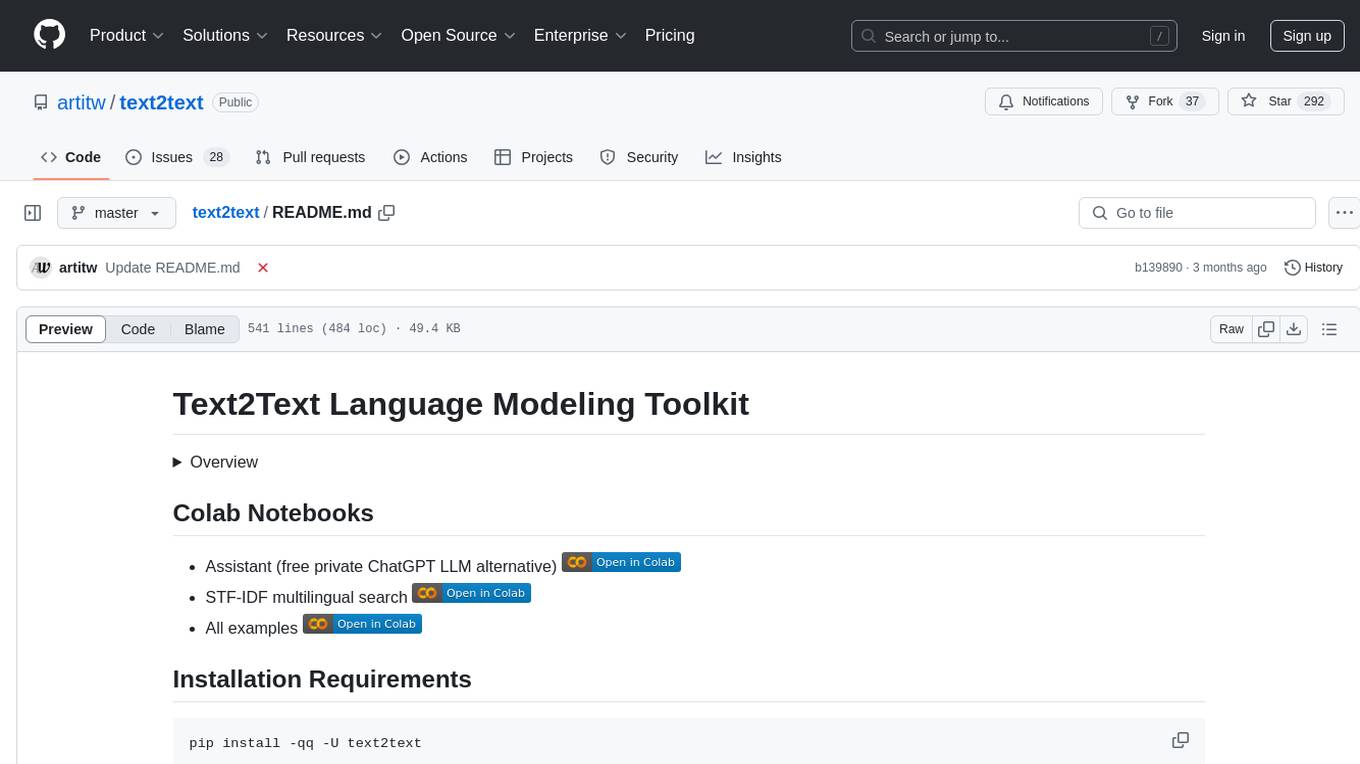
Text2Text is a comprehensive language modeling toolkit that offers a wide range of functionalities for text processing and generation. It provides tools for tokenization, embedding, TF-IDF calculations, BM25 scoring, indexing, translation, data augmentation, distance measurement, training/finetuning models, language identification, and serving models via a web server. The toolkit is designed to be user-friendly and efficient, offering a variety of features for natural language processing tasks.
README:
Overview
pip install -qq -U text2text
- Examples run with <16 GB RAM on free Colab GPUs.
| Functionality | Invocation | Result |
|---|---|---|
| Module Importing | import text2text as t2t |
Libraries imported |
| Assistant | t2t.Assistant().transform("Describe Text2Text in a few words: ") |
['Text2Text is an AI-powered text generation tool that creates coherent and continuous text based on prompts.'] |
| Language Model Setting | t2t.Transformer.PRETRAINED_TRANSLATOR = "facebook/m2m100_418M" |
Change from default |
| Tokenization | t2t.Tokenizer().transform(["Hello, World!"]) |
[['▁Hello', ',', '▁World', '!']] |
| Embedding | t2t.Vectorizer().transform(["Hello, World!"]) |
[[0.18745188, 0.05658336, ..., 0.6332584 , 0.43805206]] |
| TF-IDF | t2t.Tfidfer().transform(["Hello, World!"]) |
[{'!': 0.5, ',': 0.5, '▁Hello': 0.5, '▁World': 0.5}] |
| BM25 | t2t.Bm25er().transform(["Hello, World!"]) |
[{'!': 0.3068528194400547, ',': 0.3068528194400547, '▁Hello': 0.3068528194400547, '▁World': 0.3068528194400547}] |
| Indexer | index = t2t.Indexer().transform(["Hello, World!"]) |
Index object for information retrieval |
| Translation | t2t.Translater().transform(["Hello, World!"], src_lang="en, tgt_lang="zh") |
['你好,世界!'] |
| Data Augmentation | t2t.Variator().transform(["Hello, World!"], src_lang="en) |
['Hello the world!', 'Welcome to the world.', 'Hello to the world!',... |
| Distance | t2t.Measurer().transform(["Hello, World! [SEP] Hello, what?"]) |
[2] |
| Training/Finetuning | t2t.Fitter().transform(["Hello, World! [TGT] Hello, what?"]) |
Finetuned model saved |
| Identification | t2t.Identifier().transform(["Aj keď sa Buzz Aldrin stal až „druhým človekom“..."]) |
['sk', 'Slovak'] |
| Web Server | t2t.Serve(host='0.0.0.0', port=80) |
Web server started on host and port |
- Free private open source alternative to commercial LLMs.
- Commercial LLMs are costly, collect your data, impose quotas and rate limits that hinder development.
- Run at no cost on Google Colab free tier, so you don't even need your own device.
import text2text as t2t
asst = t2t.Assistant()
# Streaming example
chat_history = [
{"role": "user", "content": "Hi"},
{"role": "assistant", "content": "Hello, how are you?"},
{"role": "user", "content": "What should I do today?"}
]
result = asst.chat_completion(chat_history, stream=True) #{'role': 'assistant', 'content': '1. Make a list of things to be grateful for.\n2. Go outside and take a walk in nature.\n3. Practice mindfulness meditation.\n4. Connect with a loved one or friend.\n5. Do something kind for someone else.\n6. Engage in a creative activity like drawing or writing.\n7. Read an uplifting book or listen to motivational podcasts.'}
for chunk in result:
print(chunk['message']['content'], end='', flush=True)
# Running conversation
messages = []
while True:
user_input = input("User: ")
print()
messages.append({"role": "user", "content": user_input})
print("Assistant: ")
result = asst.chat_completion(messages, stream=False)
print(result["message"]["content"])
messages.append(result["message"])
print()
# Schema for structured output
from pydantic import BaseModel
class Song(BaseModel):
name: str
artist: str
result = asst.chat_completion([
{"role": "user", "content": "What is Britney Spears's best song?"}
], schema=Song)
# Song(name='Toxic', artist='Britney Spears')
# Embeddings
asst.embed(["hello, world!", "this will be embedded"])
t2t.Tokenizer().transform([
"Let's go hiking tomorrow",
"안녕하세요.",
"돼지꿈을 꾸세요~~"
])
# Sub-word tokens
[['▁Let', "'", 's', '▁go', '▁hik', 'ing', '▁tom', 'orrow'],
['▁안녕', '하세요', '.'],
['▁', '돼', '지', '꿈', '을', '▁꾸', '세요', '~~']]
t2t.Vectorizer().transform([
"Let's go hiking tomorrow",
"안녕하세요.",
"돼지꿈을 꾸세요~~"
])
# Embeddings
[[-0.00352954, 0.0260059 , 0.00407429, ..., -0.04830331,
-0.02540749, -0.00924972],
[ 0.00043362, 0.00249816, 0.01755436, ..., 0.04451273,
0.05118701, 0.01895813],
[-0.03563676, -0.04856304, 0.00518898, ..., -0.00311068,
0.00071953, -0.00216325]]
t2t.Tfidfer().transform([
"Let's go hiking tomorrow",
"안녕하세요.",
"돼지꿈을 꾸세요~~"
])
# TF-IDF values
[{'!': 0.22360679774997894,
"'": 0.44721359549995787,
',': 0.22360679774997894,
'ing': 0.22360679774997894,
'orrow': 0.22360679774997894,
's': 0.44721359549995787,
'▁Let': 0.22360679774997894,
'▁go': 0.44721359549995787,
'▁hik': 0.22360679774997894,
'▁let': 0.22360679774997894,
'▁tom': 0.22360679774997894},
{'.': 0.5773502691896258,
'▁안녕': 0.5773502691896258,
'하세요': 0.5773502691896258},
{'~~': 0.3535533905932738,
'▁': 0.3535533905932738,
'▁꾸': 0.3535533905932738,
'꿈': 0.3535533905932738,
'돼': 0.3535533905932738,
'세요': 0.3535533905932738,
'을': 0.3535533905932738,
'지': 0.3535533905932738}]
t2t.Bm25er().transform([
"Let's go hiking tomorrow",
"안녕하세요.",
"돼지꿈을 꾸세요~~"
])
# BM25 values
[{"'": 1.2792257271403649,
'ing': 1.2792257271403649,
'orrow': 1.2792257271403649,
's': 1.2792257271403649,
'▁Let': 1.2792257271403649,
'▁go': 1.2792257271403649,
'▁hik': 1.2792257271403649,
'▁tom': 1.2792257271403649},
{'.': 1.751071282233123, '▁안녕': 1.751071282233123, '하세요': 1.751071282233123},
{'~~': 1.2792257271403649,
'▁': 1.2792257271403649,
'▁꾸': 1.2792257271403649,
'꿈': 1.2792257271403649,
'돼': 1.2792257271403649,
'세요': 1.2792257271403649,
'을': 1.2792257271403649,
'지': 1.2792257271403649}]
index = t2t.Indexer().transform([
"Let's go hiking tomorrow, let's go!",
"안녕하세요.",
"돼지꿈을 꾸세요~~",
])
index.retrieve(["돼지"], k=1) #[['"돼지꿈을 꾸세요~~"']]
# Add documents
index.add(["Hello, World! 你好,世界!"])
# Remove by ids
index.remove([2]) #Removes "돼지꿈을 꾸세요~~"
# Retrieve k results per query sorted by distance
index.retrieve(["你好, World"], k=3)
To learn more, see STF-IDF.
t2t.Measurer().transform([
"Hello, World! [SEP] Hello, what?",
"안녕하세요. [SEP] 돼지꿈을 꾸세요~~"
], metric="levenshtein_distance")
# Distances
[2, 8]
# Sample texts
article_en = 'The Secretary-General of the United Nations says there is no military solution in Syria.'
notre_dame_str = "As at most other universities, Notre Dame's students run a number of news media outlets. The nine student - run outlets include three newspapers, both a radio and television station, and several magazines and journals. Begun as a one - page journal in September 1876, the Scholastic magazine is issued twice monthly and claims to be the oldest continuous collegiate publication in the United States. The other magazine, The Juggler, is released twice a year and focuses on student literature and artwork. The Dome yearbook is published annually. The newspapers have varying publication interests, with The Observer published daily and mainly reporting university and other news, and staffed by students from both Notre Dame and Saint Mary's College. Unlike Scholastic and The Dome, The Observer is an independent publication and does not have a faculty advisor or any editorial oversight from the University. In 1987, when some students believed that The Observer began to show a conservative bias, a liberal newspaper, Common Sense was published. Likewise, in 2003, when other students believed that the paper showed a liberal bias, the conservative paper Irish Rover went into production. Neither paper is published as often as The Observer; however, all three are distributed to all students. Finally, in Spring 2008 an undergraduate journal for political science research, Beyond Politics, made its debut."
bacteria_str = "Bacteria are a type of biological cell. They constitute a large domain of prokaryotic microorganisms. Typically a few micrometres in length, bacteria have a number of shapes, ranging from spheres to rods and spirals. Bacteria were among the first life forms to appear on Earth, and are present in most of its habitats."
bio_str = "Biology is the science that studies life. What exactly is life? This may sound like a silly question with an obvious answer, but it is not easy to define life. For example, a branch of biology called virology studies viruses, which exhibit some of the characteristics of living entities but lack others. It turns out that although viruses can attack living organisms, cause diseases, and even reproduce, they do not meet the criteria that biologists use to define life."
t2t.Translator().transform([
article_en,
notre_dame_str,
bacteria_str,
bio_str
], src_lang='en', tgt_lang='zh')
# Translations
['联合国秘书长说,叙利亚没有军事解决方案。',
'与大多数其他大学一样,Notre Dame的学生运行的新闻媒体渠道的数量。九个学生 - 运行的渠道包括三份报纸,两台广播电视台,以及几本杂志和杂志。 开始作为一个一页的杂志在1876年9月,该杂志的Schoolistic发行了每月两次,并声称是美国最古老的连续的大学新闻出版物,和其他杂志,TheJuggler,每年发行两次,并专注于学生文学和艺术作品。 多姆年刊每年发行。 报纸有不同的出版利益,与The Observer发表每日,主要报道大学和其他新闻,并由学生从Notre Dame和圣玛丽的学院。 与Scholastic和The Dome不同,The Observer是一个独立的公众作品,但没有教师顾',
'细菌是生物细胞的一种类型. 它们构成一个大范围的亲生微生物. 通常几微米长,细菌有许多形状,从球到杖和螺旋。 细菌是地球上出现的第一个生命形式之一,并且存在于其大多数栖息地。',
'生物学是研究生命的科学. 究竟什么是生命? 这可能听起来像一个愚蠢的问题,有一个显而易见的答案,但它并不容易定义生命. 例如,一个名为病毒学的生物学分支研究病毒,这些病毒表现出一些活体的特征,但缺乏其他。']
- The default translator requires no more than 16GB of memory.
- You can specify other pretrained translators at your own risk.
- Make sure src_lang and tgt_lang codes conform to that model.
BYOT examples
t2t.Transformer.PRETRAINED_TRANSLATOR = "facebook/mbart-large-50-many-to-many-mmt"
t2t.Transformer.LANGUAGES = {
'af_ZA': 'Afrikaans',
'ar_AR': 'Arabic',
'az_AZ': 'Azerbaijani',
'bn_IN': 'Bengali',
'cs_CZ': 'Czech',
'de_DE': 'German',
'en_XX': 'English',
'es_XX': 'Spanish',
'et_EE': 'Estonian',
'fa_IR': 'Persian',
'fi_FI': 'Finnish',
'fr_XX': 'French',
'gl_ES': 'Galician',
'gu_IN': 'Gujarati',
'he_IL': 'Hebrew',
'hi_IN': 'Hindi',
'hr_HR': 'Croatian',
'id_ID': 'Indonesian',
'it_IT': 'Italian',
'ja_XX': 'Japanese',
'ka_GE': 'Georgian',
'kk_KZ': 'Kazakh',
'km_KH': 'Khmer',
'ko_KR': 'Korean',
'lt_LT': 'Lithuanian',
'lv_LV': 'Latvian',
'mk_MK': 'Macedonian',
'ml_IN': 'Malayalam',
'mn_MN': 'Mongolian',
'mr_IN': 'Marathi',
'my_MM': 'Burmese',
'ne_NP': 'Nepali',
'nl_XX': 'Dutch',
'pl_PL': 'Polish',
'ps_AF': 'Pashto',
'pt_XX': 'Portuguese',
'ro_RO': 'Romanian',
'ru_RU': 'Russian',
'si_LK': 'Sinhala',
'sl_SI': 'Slovene',
'sv_SE': 'Swedish',
'sw_KE': 'Swahili',
'ta_IN': 'Tamil',
'te_IN': 'Telugu',
'th_TH': 'Thai',
'tl_XX': 'Tagalog',
'tr_TR': 'Turkish',
'uk_UA': 'Ukrainian',
'ur_PK': 'Urdu',
'vi_VN': 'Vietnamese',
'xh_ZA': 'Xhosa',
'zh_CN': 'Chinese'
}
t2t.Translator().transform(
["I would like to go hiking tomorrow."],
src_lang="en_XX",
tgt_lang='zh_CN'
)
['我想明天去徒步旅行。']
Back-translations useful for augmenting training data
t2t.Variator().transform([bacteria_str], src_lang='en')
Show results
# Variations
['Bacteria are a kind of biological cell. They form a large domain of prokaryotic micro-organisms. Typically a few micrometers in length, bacteria have a number of shapes, ranging from spheres to borders and spirals. Bacteria were among the first forms of life that appeared on Earth, and are present in most of its habitats.',
'Chronicles Chronicles Chronicles Chronicles Chronicles Chronicles Chronicles Chronicles Chronicles Chronicles Chronicles Chronicles Chronicles Chronicles Chronicles Chronicles Chronicles Chronicles Chronicles',
'Bacteria are a type of biological cell, forming a large scale of procariotic microbials, usually a few micrometers in length, and have many shapes, ranging from bodies to roots and heads, and bacteria were among the first forms of life that appeared on Earth, and they are present in most of their environments.',
'The bacteria are a type of biological cell. They constitute a great domain of procariotic microorganisms. Typically a few micrometres of length, the bacteria have a series of shapes, variing from spheres to rays and spirals.',
'Bacteria are a type of biological cell. They form a large range of procaryotic microorganisms. Typically, at a length of several micrometers, bacteria have a lot of shapes, between spheres and spirals. Bacteria have been among the first forms of life on Earth, and are in most of its habitats.',
'Bacteria type biological cell. They make up a large domain of procariotic microorganisms. typically several micrometers long, bacteria have a number of formats, from spheres to roses and spirals. bacteria were among the first life formats to appear on Earth, and are present in most of its habitats.',
'Bacteria are types of biological cells. They make up a great home of procaryotical microorganisms. Usually with a few micrometers of length, bacteria have several shapes that are located from spheres to species and spirals. Bacteria were from the first forms of life that appeared on Earth, and are found in many of their animals.',
'Bacteria are a type of biological cell. They make up a large range of procariotic microorganisms. Usually several micrometers in length, bacteria have a number of shapes ranging from spheres to stairs and spirals. Bacteria are among the first forms of life that appear on Earth, and are available in most of its habitats.',
'Bacteria are a type of organic cell. They create a larger area of procreatic microorganisms. usually a few micrometers long, the bacteria have a number of sizes, the streets and spirals from the surfers. the bacteria were in the first life sizes appeared on Earth, and present in most of its reality.',
'Bacteria are a type of biological cell. They constitute a large domain of prokaryotic microorganisms. Typically a few micrometers in length, bacteria have a number of shapes, ranging from spheres to rods and spirals. Bacteria were among the first life forms to appear on Earth, and are present in most of its habitats.',
'The bacteria are a type of biological cell.They make a large domain of procarytic microorganisms.Typically a few micrometers long, the bacteria have a number of forms, from spheres to roots and spirals.The bacteria were among the first life forms that appear on Earth, and are present in most of their habitats.',
'Bacteria are a type of biological cell. they constitute a great domain of prokarotic microorganisms. Typically a few micrometers of length, the bacteria have a series of shapes, which vary from spheres to wheels and spirals. The bacteria were among the first forms of life that appear on Earth, and are present in most of their habitats.',
'The bacteria are a type of biological cell. The bacteria are a different domain of prokaryotic microorganisms. The bacteria are a form, from spheres to wraps and spirals. The bacteria is one of the first life forms of appearance on Earth, and is one of the habitats.',
'Bacteria are a type of biological cells. they form a large area of prokaryotic microorganisms. Typically several micrometers in length, bacteria have several shapes, from spheres to roots and spirals. Bacteria were among the first forms of life that appeared on Earth, and are present in most of its residential spaces.',
'Bacteria is a type of biological cell. It is fat in the fat in the prokaryotic microorganisms. The fat in the fat in the fat in the fat in the fat in the fat in the fat in the fat in the fat in the fat in the fat in the fat in the fat in the fat in the fat in the fat in the fat in the fat in the fat in the fat.',
'Bacteria are a type of biological cell. They form a large domain of prokaryotic microorganisms. Typically a couple of micrometers in length, bacteria have a variety of forms, ranging from spheres to layers and spirals. Bacteria were among the first forms of life that appeared on Earth, and are present in most of its habitats.',
'Bacteria are a type of biological cell. They form a large range of prokaryotic microorganisms. Normally a few micrometers in length, bacteria have a number of forms, from spheres to roots and spirals. Bacteria were among the first forms of life to appear on Earth, and are present in most of their habitats.',
'Bacteria are a kind of organic cells. they make up a large range of prehyroid microorganisms. Usually a few micrometer length, bacteria have a number of forms, ranging from spheres to roots and spherals. The bacteria were among the first forms of life that appeared on Earth, and are present in most of its habitats.',
'Bacteria are a type of biological cell. They constitute a large domain of prokaryotic microorganisms. Typically a few micrometers in length, bacteria have a number of shapes, ranging from spheres to roots and spirals. Bacteria were among the first life forms to appear on Earth, and are present in most of its habitats.',
'Bacteria are a type of biological cell. they constitute a great domain of procariotic microorganisms. Typically a few micrometers of length, bacteria have a series of shapes, which vary from spheres to roots and spirals. Bacteria were among the first forms of life that appeared on Earth, and are present in most of their habitats.',
'Bacteria are a type of biological cells. They form a large area of prokarotic microorganisms. usually a few micrometers long, bacteria have a number of forms that range from spheres to roots and spirals. Bacteria were among the first forms of life that appeared on Earth, and are present in most of their habitats.',
'Bacteria are a type of biological cells.They make up a large range of procaryotic microorganisms.The bacteria usually have a variety of shapes, ranging from branches to branches and spirals.The bacteria were among the first vital forms that appear on earth and are present in most of its habitats.',
'Bacteria are a type of biological cell. They constitute a large domain of prokaryotic microorganisms. Typically a few micrometers in length, bacteria have a number of shapes, ranging from spheres to rods and spirals. Bacteria were among the first life forms to appear on Earth, and are present in most of its habitats.',
'Bacteria are a type of biological cell. They form a large area of prokaryotic microorganisms. Typically a few micrometers length, bacteria have several forms, ranging from spheres to roots and spirals. Bacteria were among the first forms of life that appeared on Earth, and are present in most of its habitat environments.',
'Bacteria are a type of biological cell. They constitute a large range of procaryotic microorganisms. Usually, a few micrometers long, the bacteria have a number of shapes, ranging from spheres to roots and spirals. The bacteria were among the first forms of life to appear on Earth, and are present in most of its habitats.',
'Bacteria are a type of biological cells. They set up a large domain of prokaryotic microorganisms. Typically a few micrometers in length, bacteria have a variety of forms, ranging from spheres to rectum and spirals. Bacteria are among the first forms of life that come to the Earth, and are in the most of their habitats.',
'Inexperienced, Inexperienced, Inexperienced, Inexperienced, Inexperienced, Inexperienced, Inexperienced, Inexperienced, Inexperienced, Inexperienced, Inexperienced, Inexperienced, Inexperienced',
'Bacteria are a type of biological cell. They constitute a large domain of prokaryotic microorganisms. Typically a few micrometres in length, bacteria are a number of shapes, ranges from spheres to roads and spirals. Bacteria were among the first life forms to appear on Earth, and are present in most of its habitats.',
'Bacteria are a type of biological cell. They constitute a great domain of procariotic microorganisms. Typically a few micrometers of length, the bacteria have a series of shapes, which vary from spheres to roots and spirals. The bacteria were among the first forms of life that appeared on Earth, and are present in most of their habitats.',
'On the other hand, it is important to note that in the past few decades, there is a significant increase in the number of people living in the country, and there is a significant increase in the number of people living in the country, and there is a significant increase in the number of people living in the country, and there is a significant increase in the number of people living in the country.',
'Bacteria is a type of biological cell. It has a big domain and prokaryotic microorganisms. It has a micrometres at the time, bacteria has in a number of shapes, ranging from spheres to rods and spirals. Bacteria is in the first and life shapes to appear on Earth, and is in the best and best forms.',
'Bacteria are a type of biological cells.They constitute a large area of procreatic microorganisms.Generally a few micrometers long, bacteria have a number of forms, formed from literature to waves and spirals.Bacteria were among the first forms of life to appear on Earth, and they exist in most aspects.',
'Bacteria are a type of organic cells. They create a large range of procariotic microorganisms. Usually in a few micrometers length, bacteria have many shapes, ranging from spare to wire and wire. Bacteria were one of the first forms of life that appeared on Earth, and are present in most of their population.',
'Bacteria are a type of biological cell. they make a large domain of procarytic microorganisms. usually a few micrometers in length, bacteria have a number of forms, from spheres to roots and spirals. bacteria were among the first forms of life that appear on Earth, and are present in most of their habitats.',
'Bacteria are a kind of biological cell. It represents a large domain of pro-cariotic microorganisms. Typically in some micrometres of length, bacteria have a lot of training, from the spheres of their hands and spirals. Bacteria were one of the first training of life appearing in the world, and are present in the majority of their habitats.',
'Bacteria are a kind of biological cell. These form a large range of procarytic microorganisms. Generally, some micrometer long bacteria are in a variety of shapes, from spheres to fiber and spirals. Bacteria were among the first forms of life to appear on Earth and are present in most of their habitats.',
"Related Topics: Faith Faith as a Function of Prayer Faith as Gift of God Faith, Living Fasting Loyalty Prayer Prayer as Contact with God Prayer as Conversation Prayer as Fellowship Prayer's Purpose Prayer, Effectiveness in Prayer, Power of Praying Always Praying at All Times Praying without Ceasing Relationship with God Trust Unbelief Weak Prayer Life",
'Bacteria are a type of biological cell. they form a large domain of prokaryotic microorganisms. usually a few micrometers long, bacteria have several shapes, from spheres to roots and spirals. Bacteria are among the first forms of life that appear on Earth, and present in most of its habitats.',
'Bacteria is a type of biological cell. It provides a big domain of prokaryotic microorganisms. It provides some micrometres to spread, bacteria has many types, such as spheres and rods and spirals. Bacteria is the primary high-type species to be found on Earth, and is covered by many of its habitats.',
'The bacteria is a type of biological cell. The bacteria is a type of bacteria that can be found to be found to be found to be found to be found to be found to be found to be found to be found to be found to be found to be found to be found to be found to be found to be found.',
'Bacteria are a type of biological cells. They are a large area of prokaryotic microorganisms. Typically a few micrometers in length, bacteria have a number of species, ranging from areas to wounds and spirals. Bacteria were among the first biological phenomena to appear on the earth, and are located in the most biological phenomena.',
'Bacteria are a type of biological cell. they constitute a wide domain of procariotic microorganisms. usually a few micrometers of length, bacteria have a number of shapes, ranging from spheres to roots and spirals. bacteria are among the first forms of life that appear on Earth, and are present in most of its habitats.',
'Bacteria are a type of biocells They make up a wide range of procariotic microorganisms, usually in a number of micrometres of length, bacteria have a variety of shapes from spheres to wings and spirals Bacteria are one of the first forms of life that appear on Earth and are present in most of their habitat.',
'Bacteria is a type of biological cell.It is a large domain of prokaryotic microorganisms.Al a few micrometers in length, bacteria have a number of shapes, spread from spheres to grass and spiral.Bacteria are among the first forms of life to be displayed on Earth, and are present in most habitats.',
'Bacteria are a type of biological cell. They constitute a large domain of prokaryotic microorganisms. Typically a few micrometers in length, bacteria have a number of shapes, ranging from spheres to rods and spirals. Bacteria were among the first life forms to appear on Earth, and are present in most of its habitats. (cancer, transport, transport, transport, transport)',
'The bacteria have biological cells. They are spread by procariotic microorganisms. The substance has several micrometers, the bacteria have many forms, spheres and spirals.',
'Tag is a type of tag tag tag tag tag tag tag tag tag tag tag tag tag tag tag tag tag tag tag tag tag tag tag tag tag tag tag tag tag tag tag tag tag tag tag tag tag tag tag tag tag tag tag tag tag tag tag tag tag tag tag tag tag tag tag tag tag',
'It is true that there is a great deal of interest in the world, and there is a great deal of interest in the world, and there is a great deal of interest in the world, and there is a great deal of interest in the world, and there is a great deal of interest in the world, and there is a great deal of interest in the world, and there is a great deal of interest in the world.',
'Bacteria are a type of biological cells.They make up a large range of procariotic microorganisms.In general, a few meters long, the bacteria have several forms from spheres to roots and spheres.The bacteria were one of the first forms of life to appear on Earth, and exist in most ecosystems.',
'Bacteria are a type of biological cell. They form a large domain of prokaryotic microorganisms. Typically a few micrometers of length, bacteria have a number of forms, from spheres to spheres and spirals. Bacteria were between the first forms of life and appeared on Earth, and are in the majority of habitats.',
'Bacteria is a type of biological cell. They are in a big domain of prokaryotic microorganisms. Typically a few micrometres in length, bacteria has a number of shapes, ranging from spheres to roads and spirals. Bacteria was among the first life forms to appear on Earth, and are present in most of its habitats.',
'Bacteria of makolinhot of makolinhot of makolinhot of makolinhot of makolinhot of makolinhot of makolinhot of makolinhot of makolinhot of makolinhot of makolinhot of makolinhot of makolinhot of makolinhot of makolinhot of makolinhot of makolinhot of makolinhot of makolinhot of makolinhot of makolinhot of makolinhot.',
'Bacteria are a type of biological cell. They constitute a large domain of prokaryotic microorganisms. Types of micrometers in the latter, bacteria have a number of shapes, ranging from spheres to rods and spirals. Bacteria were among the first forms of life to appear on Earth, and are renowned in more than its kind.',
'Bacteria are a type of biological cells. They make up a large area of procarytic microorganisms. Usually a few micrometers long, bacteria have several forms ranging from spheres to branches and spirals. Bacteria were among the first forms of life that appeared on Earth, and are in many of its habitats.',
'Bacteria are a type of biological cells. they form a large range of prokaryotic microorganisms. usually a few micrometers long, bacteria have several shapes, from spheres to roots and spirals. bacteria were among the first forms of life that appeared on Earth, and are located in the majority of its habitat.',
'The bacteria is a type of biological cell. It creates a large scale of prokaryotic microorganisms. Usually small, the bacteria have a variety of forms, to spheres and spirals. The bacteria is one of the first forms of life found in the earth, and is present in most of its habitats.',
'Bacteria are a type of biological cells. they represent a large area of procariotic microorganisms. Usually several micrometers in length, bacteria have a large number of shapes, ranging from spheres to genes and spirals. Bacteria were among the first forms of life to appear on Earth, and are present in most of its habitats.',
'bacteria are a type of biological cell. They constitute a large domain of prokaryotic microorganisms. Typically a few micrometers in length, bacteria have a number of shapes, ranging from spheres to rods and spirals. bacteria were among the first life forms to appear on Earth, and are present in most of its habitats. bacteria are among the first life forms to appear on Earth, and are present in most of its habitats. bacteria are among the first life forms to appear on Earth, and are present in most of its habitats. bacteria are among the first life forms to appear on Earth.',
'Bacteria are a biological pattern. They are a multi-facet of procariotic microorganisms. Moreover, with a micrometer, there are different types of bacteria shapes and spirals. The bacteria was one of the first life patterns in the world and it has a large pattern.',
'Bacteria are types of biological cells. They become a large domain of procariotic microbes. Usually some micrometers are long, there are many shapes of bacteria, from spera to spira and spila. Bacteria were the first life shapes to appear on Earth, and are present in most of them.',
'Bacteria are a kind of biological cell.They form a large domain of prokaryotic microorganisms.Overall a few micrometers in length, bacteria have several shapes, from spheres to roots and spirals.Bacteria are among the first forms of life that appear on Earth, and present in most of its habitats.',
'bacteria are a type of biological cell. They constitute a large domain of prokaryotic microorganisms. Typically a few micrometres in length, bacteria have a number of shapes, ranging from spheres to rods and spirals. bacteria were among the first life shapes to appear on Earth, and are present in most of its habitats. The bacteria kind kind kind kind kind kind kind kind kind kind kind kind kind kind kind kind kind kind kind kind kind kind kind kind kind kind kind kind kind kind kind kind kind kind kind kind kind kind kind kind kind kind kind kind kind kind kind kind kind kind kind kind kind kind kind kind kind kind kind kind kind kind kind kind kind kind kind kind kind kind kind kind kind kind kind kind kind kind kind kind kind kind kind kind kind kind kind kind kind kind kind kind kind kind kind kind kind kind kind kind kind kind kind kind kind kind kind kind',
'“That’s what I’m going to do, I’m going to do, I’m going to do, I’m going to do, I’m going to do, I’m going to do, I’m going to do, I’m going to do, I’m going to do, I’m going to do, I’m going to do, I’m going to do, I’m going to do.”',
'Bacteria are a kind of biological cell. They form a large domain of prokaryotic microorganisms. Typically a few micrometers in length, bacteria have a number of shapes, ranging from spheres to rocks and spirals. Bacteria were among the first forms of life that appear on Earth, and are present in most of the habitats.',
'Bacteria are a type of biological cell. They form a large area of prokaryotic microorganisms. Usually a few micrometers in length, bacteria have a variety of forms, from spheres to rows and spirals. Bacteria were among the first life forms that appeared on Earth, and are present in most of its habitats.',
'small small small small small small small small small small small small small small small small small small small small small small small small small small small small small small small small',
'Bacteria are a type of biological cell, they constitute a large range of procariotic microorganisms, typically micrometers long, bacteria are a variety of shapes, from spheres to wheels and spirals, and bacteria are among the first forms of life that appeared on Earth, and are present in most of its habitats.',
'bacteria are a type of biological cell. They constitute a large domain of prokaryotic microorganisms. Typically a few micrometres in length, bacteria have a number of shapes, ranging from spheres to roads and spirals. bacteria were among the first life forms to appear on Earth, and are present in most of its habitats.',
'Bacteria is a kind of bacteria. They have a large area of prokaryotic microorganisms. Usually some micrometers are a kind of bacteria, from fresh to color and from fresh. Bacteria as first bacteria as bacteria as bacteria as bacteria as bacteria as bacteria as bacteria as bacteria as bacteria as bacteria as bacteria as bacteria as bacteria as bacteria as bacteria as bacteria as bacteria as bacteria as bacteria as bacteria as bacteria as bacteria as bacteria as bacteria as bacteria as bacteria.',
'Bacteria are a type of biological cells. they make up a large area of prokaryotic microorganisms. usually a few micrometers long, bacteria have a number of shapes, from spheres to corners and spirals. Bacteria were among the first forms of life that appeared on Earth, and are present in most of its habitats.',
'Bacteria are a type of biological cell. They form a large range of procariotic microorganisms. In the usual length of several micrometers, bacteria have many shapes, from shapes to colors and spirals. Bacteria are in the first life shapes that appear on earth, and are present in many beauty.',
'Bacteria are a type of biological cell. they constitute a great domain of procarotic microorganisms. typically, some micrometers of length, the bacteria have a number of shapes, ranging from spheres to roots and spirals. the bacteria were among the first forms of life that appeared on Earth, and are present in most of their habitats.',
'Bacteria are a type of biological cell. they constitute a large range of procariotic microorganisms. usually, at a few micrometers of length, bacteria have a number of forms, from spheres to rows and spirals. bacteria have been among the first forms of life that appeared on Earth, and are present in most of its habitats.',
'Bacteria are a type of biological cells. They make up a large domain of procariotic microorganisms. As a rule, several micrometers in length, bacteria have a number of forms, from spheres to births and spirals. Bacteria were among the first forms of life that appeared on Earth, and are present in most of their fields.',
'Bacteria is a section of biological negative. These are a large section of procariotic microorganisms. Generally, in the length of several micrometers, bacteria are in different forms, in sperm and sperm. Bacteria were in the earlier life forms of appearance on earth, and most of them are in life.',
'bacteria are a type of biological cell. They constitute a large domain of prokaryotic microorganisms. typically a few micrometers in length, bacteria have a number of shapes, ranging from spheres to rods and spirals. bacteria were among the first life forms to appear on Earth, and are present in most of its habitats. bacteria are among the first life forms to appear on Earth, and are present in most of its habitats. bacteria are among the first life forms to appear on Earth, and are present in most of its habitats.',
'Bacteria are a type of biological cells. they form a large area of prokaryotic microorganisms. Typically several micrometers in length, bacteria have several shapes, ranging from spheres to tribes and spirals. Bacteria were among the first forms of life that appeared on Earth, and are present in most of its living places.',
'Bacteria are a type of biological cell. they make up a large area of procarotic microorganisms. Usually a few micrometres of length, bacteria have a number of forms, from the sphere to the wings and spirals. Bacteria were among the first life forms that occur on Earth, and are present in most of their habitats.',
'Bakteer is from mid to mid to mid to mid to mid to mid to mid to mid to mid to mid to mid to mid to mid to mid to mid to mid to mid to mid to mid to mid to mid to mid to mid to mid to mid to mid to mid to mid to mid to mid to mid to mid to mid to mid to mid to mid to mid to mid to mid to mid to mid to mid to mid to mid to mid to mid to mid to mid to mid to mid to mid to mid to mid to mid to mid to mid to mid to mid to mid to mid to mid',
'Bacteria are a type of biological cells.They make up a large range of prokaryotic microorganisms.Typically some micrometers in length, bacteria have a number of forms, dispersing from the sphere to the root and spirals.Bacteria were among the first forms of life that appeared on Earth, and are present in most of its habitats.',
'Bacteria are a type of biological cell.They make up a large domain of procariotic microorganisms.Generally a few micrometers in length, bacteria have a range of shapes, ranging from spheres to genes and spirals.Bacteria were among the first forms of life that appear on Earth, and are present in most of its habitats.',
'Bacteria, bacteria, bacteria, bacteria, bacteria, bacteria, bacteria, bacteria, bacteria, bacteria, bacteria, bacteria, bacteria, bacteria',
'Bacteria are a type of biological cell. They have a large domain of prokaryotic microorganisms. Usually a few micrometers long, bacteria have a number of shapes, spreading from spheres to roots and spirals. Bacteria are among the first forms of life that appear on Earth, and are in most habitats.',
'Bacteria are a type of biological cell. They make up a large area of prokaryotic microorganisms. Usually a few micrometers in length, bacteria have a number of forms, ranging from spheres to rows and spirals. Bacteria were among the first forms of life to appear on Earth, and are present in most of its habitats.',
'Bacteria are a kind of biological cell. They make a large area of prokaryotic microorganisms. Usually several micrometres of time, bacteria have several varieties, from spheres to color and spirals. Bacteria were among the first kinds of life to appear on the earth, and are present in many parts of its environment.',
'This is the first time I’ve been able to do it, and I’ve been able to do it, I’ve been able to do it, I’ve been able to do it, I’ve been able to do it, I’ve been able to do it.',
'Bacteria are a type of biological cells. They generate a large area of prokaryotic microorganisms. Normally, several micrometers, the bacteria have multiple shapes from round to round and round. The bacteria is one of the first forms of life that appears on the earth and is found in most of its environment.',
'The bacteria are a type of biological cell. These are a large domain of prokaryotic microorganisms. Typically in some micrometres of length, the bacteria have a number of shapes, from spheres to wraps and spirals. The bacteria are one of the first forms of life emerging on Earth, and are available in more habitats.',
'Go and go and go and go and go and go and go and go.',
'Bacteria are a biological type of cell. They form a large range of procaryotic microorganisms. typically in a few micrometers length, bacteria have a series of shapes, from spheres to roots and spirals. Bacteria have been among the first forms of life that appear on Earth and are present in most of their living areas.',
'Bacteria are a type of biological cells. they form a large sphere of procariotic microorganisms. As a rule, a few micrometers of length, bacteria have a number of forms that vary from spheres to cows and spirals. Bacteria were among the first forms of life that appear on Earth, and present in most of its vital objects.',
'Bacteria are a section of biological cells, they build a large place of procaryotic microorganisms, generally in a range of several micrometers, there are a large number of bacteria shapes, from spiders to wrinkles and spirals, bacteria were one of the first forms of life that appeared on earth, and are present in most populations.',
'Bacteria are biological cells. They accumulate prokaryotic microorganisms. In a typical micrometer length, bacteria accumulate from sphera to sphera to sphera. Bacteria were one of the first forms of life on Earth, and are present in most biologies.',
'Bacteria are a type of biological cell. They form a large range of prokaryotic microorganisms. Usually, a few micrometres in length, bacteria have a number of shapes, from crystals to roots and crystals. bacteria are one of the first forms of life appearing on Earth, and present in most of its organisms.',
'Bacteria is a type of biological cell. They constitute a large domain of prokaryotic microorganisms. Typically a few micrometres in length, bacteria have a number of shapes, ranging from spheres to rods and spirals. Bacteria was among the first life forms to appear on Earth, and are present in most of its habitats. Bacteria were among the first life forms to appear on Earth, and are present in most of its habitats.',
'The bacteria is a type of biological cell. The bacteria are prokaryotic microorganisms. According to many micrometres, the bacteria are many forms, from spheres to roads and spirals. The bacteria are the first life forms to appear on Earth, with many habitats.',
'Bacteria is a type of biological cell. They represent a large area of prokaryotic microorganisms. Types of a little micrometer in the acteria, bacteria have a number of forms, refer to spheres and spirals. Bacteria are among the first life forms to appear on Earth, and are present in most of the bacteria.',
'Bakteries are a type of biological cell. They were the best of prokaryotic microorganisms. They were one of the many micrometres, the bacteria are a lot of processes, from processes and processes. Bakteries are one of the processes of processes that are processed on Earth, and they are processed in all processes.',
'Bacteria are a type of biocells, they make up a large area of probiotic microorganisms, usually several meters long bacteria have several shapes, from branches to roots and spirals, bacteria are one of the first forms of life that appear on Earth and are present in most of their habitats.',
'The bacteria is a type of biological cells. The bacteria is a large area of prokaryotic microorganisms. The bacteria is a long micrometres, the bacteria is a spheres in roads and spirals. The bacteria is among the data, data, data, data and data.']
Finetune cross-lingual model on your data
result = t2t.Fitter().transform(["Hello, World! [TGT] 你好,世界!"],
src_lang="en",
tgt_lang="zh",
num_epochs=10,
save_directory="model_dir"
)
# load and use model from saved directory
t2t.Transformer.PRETRAINED_TRANSLATOR = "model_dir"
t2t.Translator().transform("Hello, World!", src_lang="en", tgt_lang="zh")
Identify the language of a text. Not yet accurate for short sequences (<10 tokens)
t2t.Identifier().transform(["Aj keď sa Buzz Aldrin stal až „druhým človekom“, ktorý otlačil svoju nohu do povrchu Mesiaca...",])
# Prediction
`['sk', 'Slovak']`
We aim to serve all functionality above
# Start web server
t2t.Server(host='0.0.0.0', port=80)
# Make POST requests
import socket
import requests
address = socket.gethostbyname(socket.getfqdn(socket.gethostname()))
url = f"http://{address}"
transformer = "Translator"
payload = {
"input_lines": ["hello", "world"],
"src_lang": "en",
"tgt_lang": "ko",
}
r = requests.post(f"{url}/{transformer}", json=payload)
print(r.json()) #{'result': ['안녕하세요', '세계']}
# Indexer actions
r = requests.post(f"{url}/Indexer/add", json=payload)
r = requests.post(f"{url}/Indexer/size")
r = requests.post(f"{url}/Indexer/search", json=payload)
r = requests.post(f"{url}/Indexer/retrieve", json=payload)
payload["ids"] = [0,1]
r = requests.post(f"{url}/Indexer/remove", json=payload)
For questions or help using Text2Text, please submit a GitHub issue.
To cite this work, use the following BibTeX citations.
@article{stfidf,
doi = {10.48550/ARXIV.2209.14281},
url = {https://arxiv.org/abs/2209.14281},
author = {Wangperawong, Artit},
title = {Multilingual Search with Subword TF-IDF},
publisher = {arXiv},
year = {2022},
}
@misc{text2text@2020,
author={Wangperawong, Artit},
title={Text2Text Language Modeling Toolkit},
year={2020},
publisher = {GitHub},
journal = {GitHub repository},
howpublished = {\url{https://github.com/artitw/text2text}},
url = {https://github.com/artitw/text2text}
}
There are many ways you can contribute:
- Ask or answer a question in Issues
- Share your experiences on using Text2Text
- Report bugs with information to reproduce
- Request for new features or functionality
- Improve code by submitting a pull request with outputs demonstrating the change
- See projects, comment on a task issue to get involved
Please adhere to our code of conduct when participating in this project.
For Tasks:
Click tags to check more tools for each tasksFor Jobs:
Alternative AI tools for text2text
Similar Open Source Tools

text2text
Text2Text is a comprehensive language modeling toolkit that offers a wide range of functionalities for text processing and generation. It provides tools for tokenization, embedding, TF-IDF calculations, BM25 scoring, indexing, translation, data augmentation, distance measurement, training/finetuning models, language identification, and serving models via a web server. The toolkit is designed to be user-friendly and efficient, offering a variety of features for natural language processing tasks.
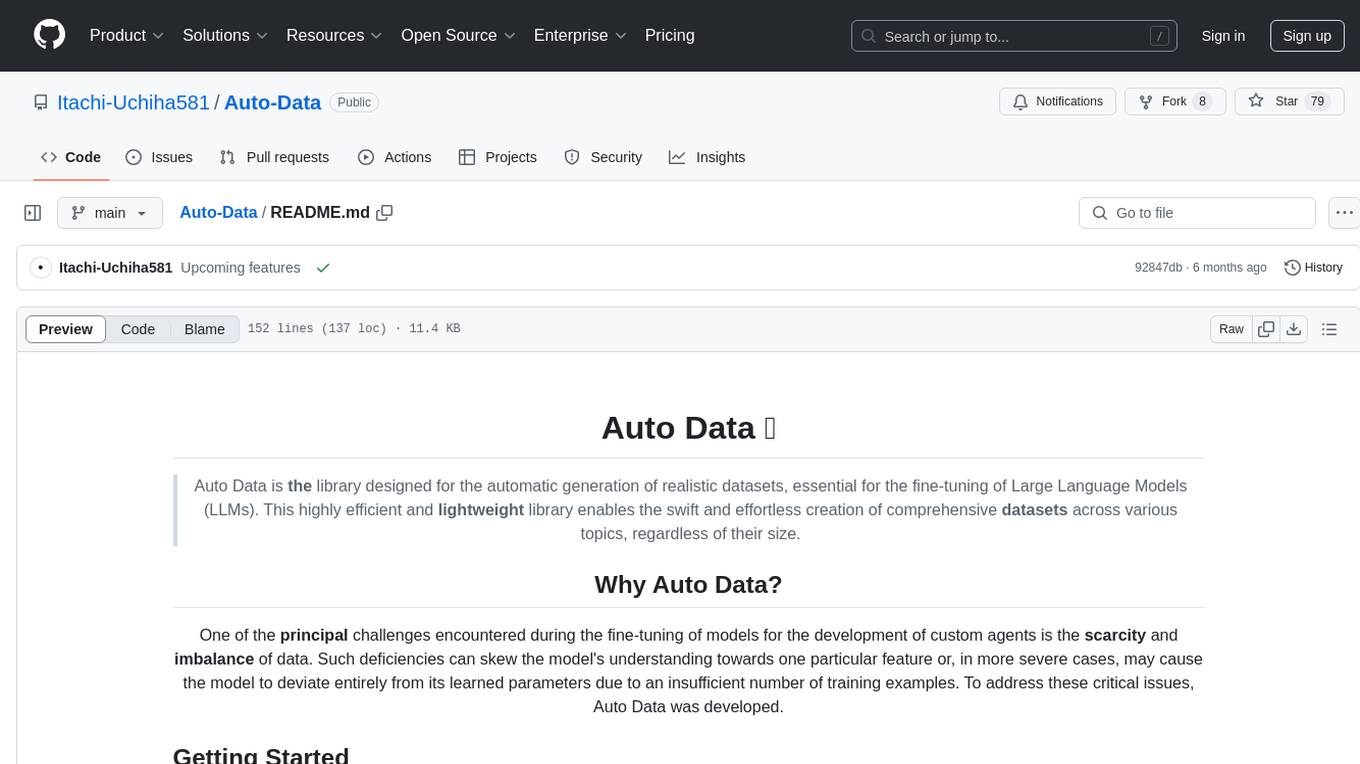
Auto-Data
Auto Data is a library designed for the automatic generation of realistic datasets, essential for the fine-tuning of Large Language Models (LLMs). This highly efficient and lightweight library enables the swift and effortless creation of comprehensive datasets across various topics, regardless of their size. It addresses challenges encountered during model fine-tuning due to data scarcity and imbalance, ensuring models are trained with sufficient examples.
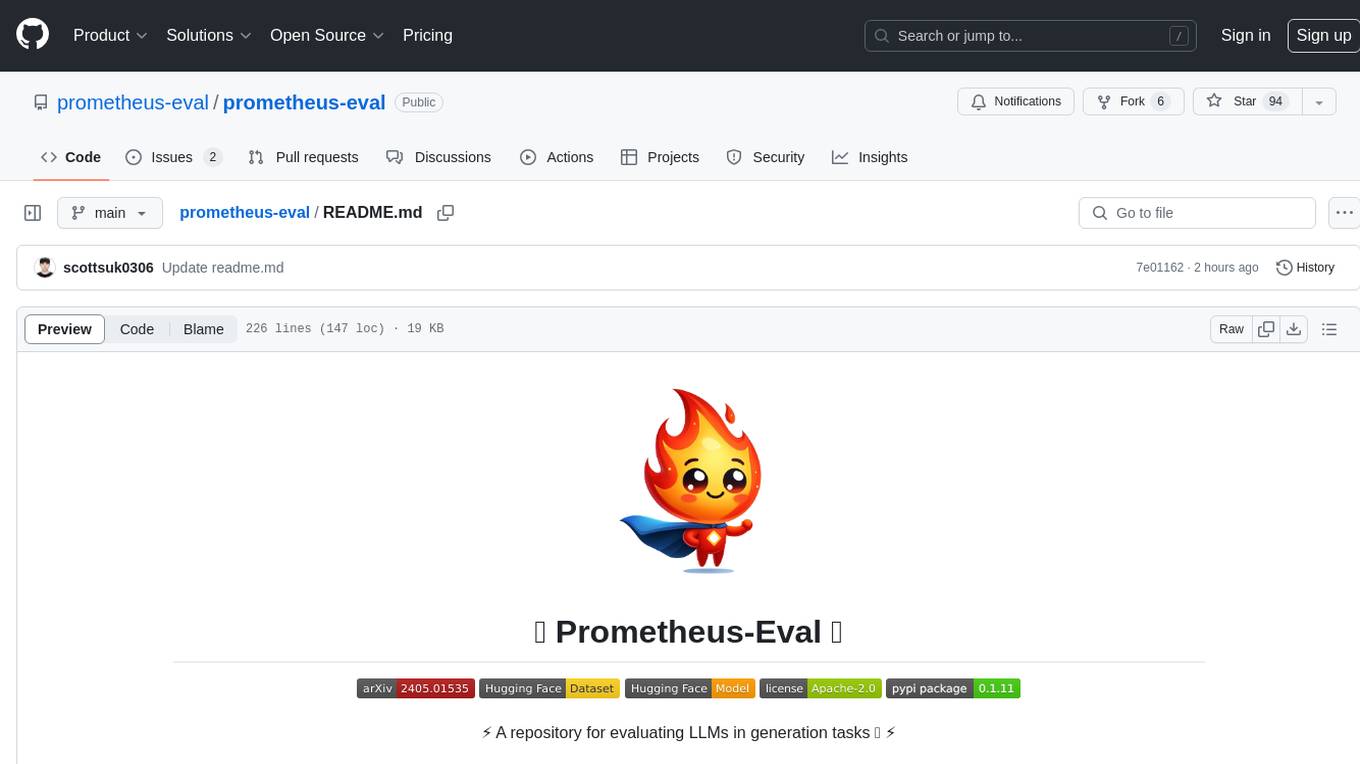
prometheus-eval
Prometheus-Eval is a repository dedicated to evaluating large language models (LLMs) in generation tasks. It provides state-of-the-art language models like Prometheus 2 (7B & 8x7B) for assessing in pairwise ranking formats and achieving high correlation scores with benchmarks. The repository includes tools for training, evaluating, and using these models, along with scripts for fine-tuning on custom datasets. Prometheus aims to address issues like fairness, controllability, and affordability in evaluations by simulating human judgments and proprietary LM-based assessments.
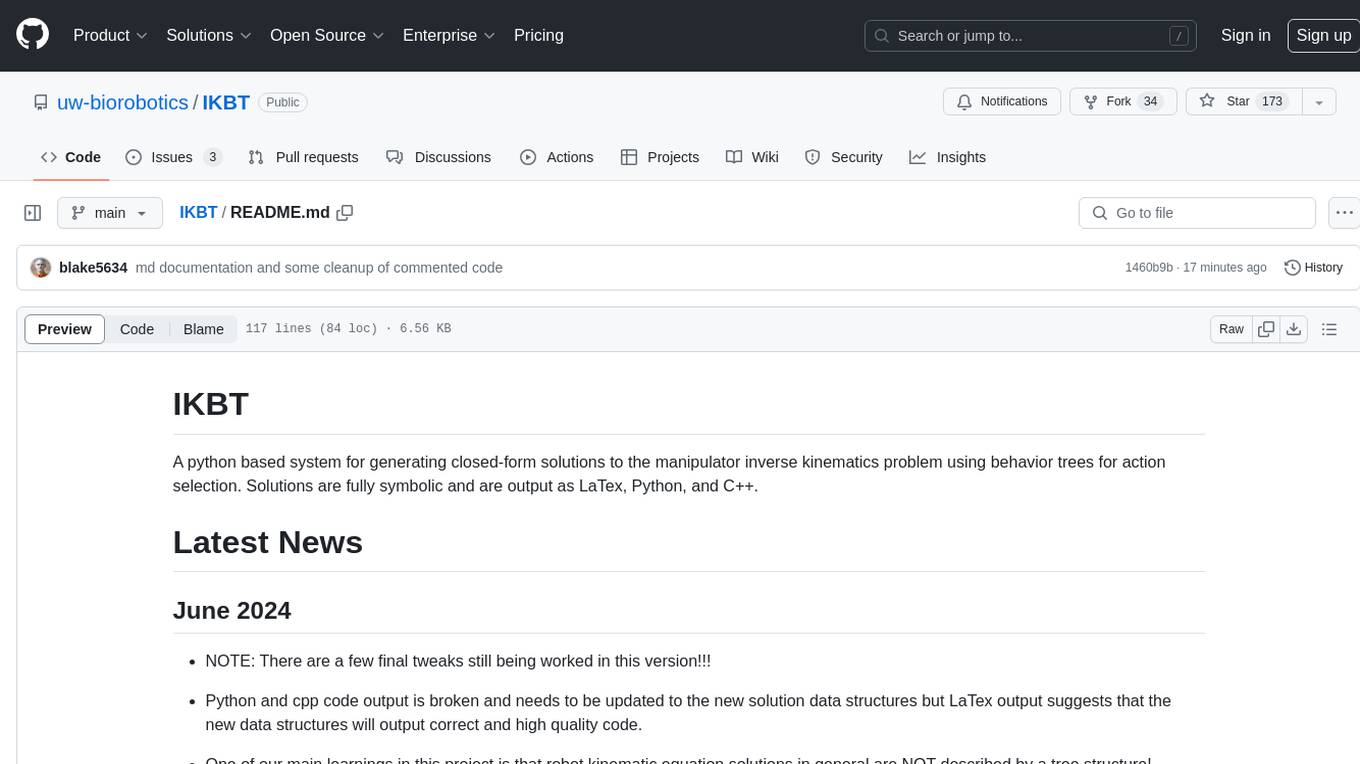
IKBT
IKBT is a Python-based system for generating closed-form solutions to the manipulator inverse kinematics problem using behavior trees for action selection. Solutions are fully symbolic and are output as LaTex, Python, and C++. The tool automates closed-form kinematics solving by organizing solution algorithms in a behavior tree, incorporating frequently used knowledge, generating a dependency graph of joint variables, and providing features for automatic documentation and code generation. It is implemented in Python with minimal dependencies outside of the standard Python distribution.
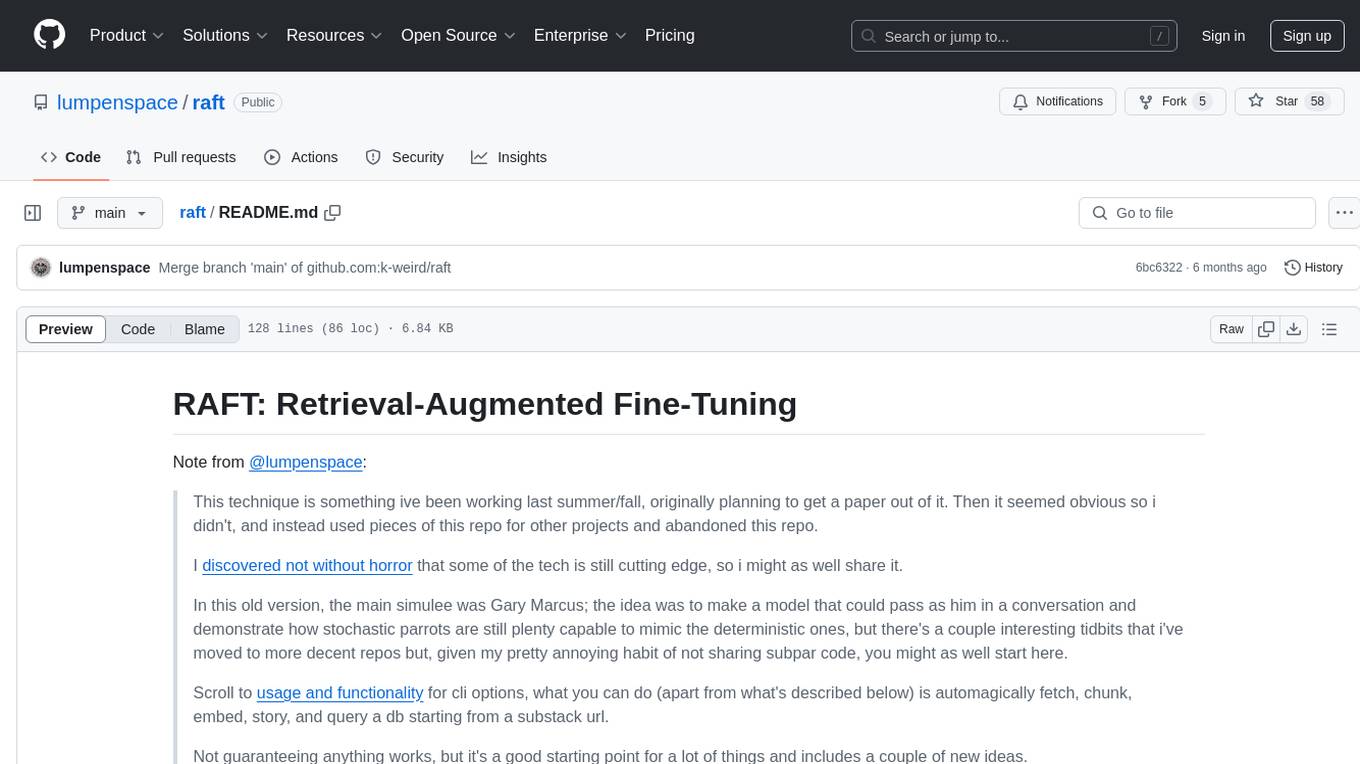
raft
RAFT (Retrieval-Augmented Fine-Tuning) is a method for creating conversational agents that realistically emulate specific human targets. It involves a dual-phase process of fine-tuning and retrieval-based augmentation to generate nuanced and personalized dialogue. The tool is designed to combine interview transcripts with memories from past writings to enhance language model responses. RAFT has the potential to advance the field of personalized, context-sensitive conversational agents.
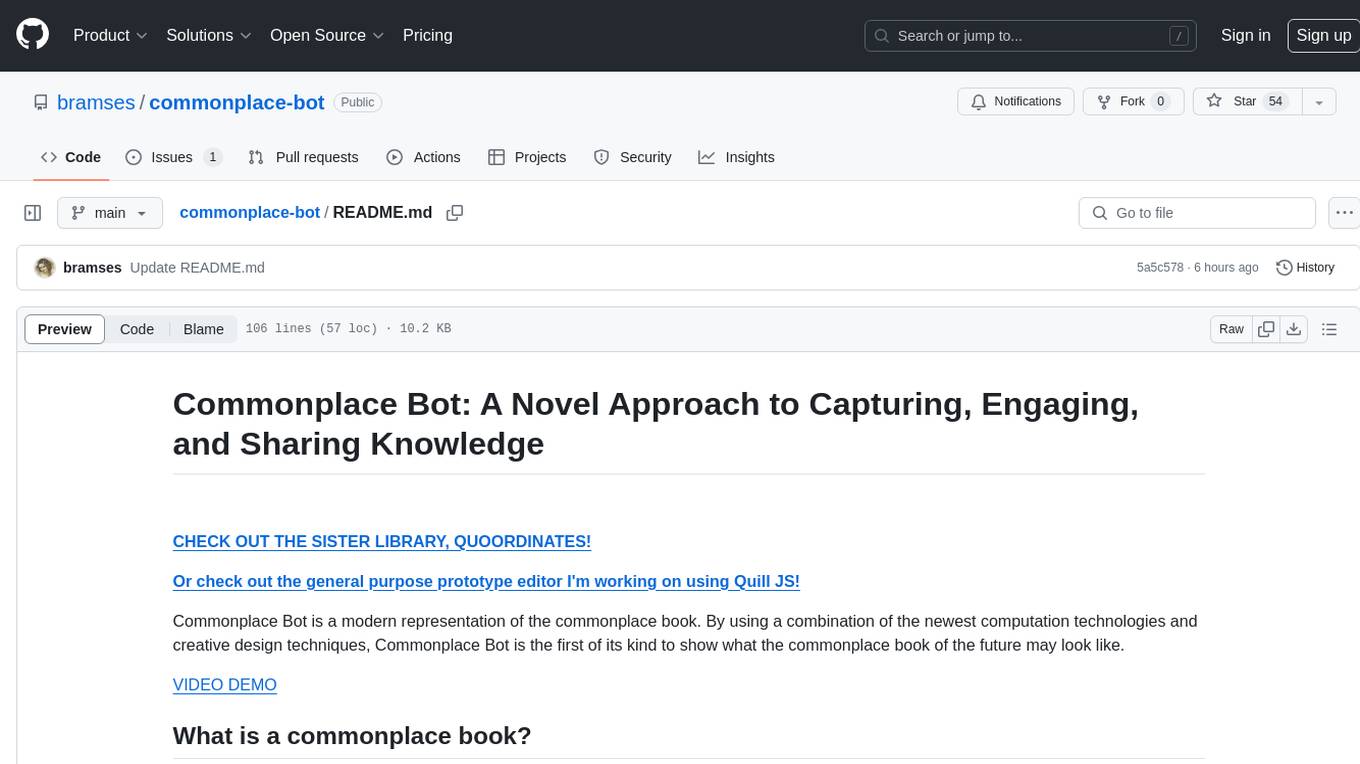
commonplace-bot
Commonplace Bot is a modern representation of the commonplace book, leveraging modern technological advancements in computation, data storage, machine learning, and networking. It aims to capture, engage, and share knowledge by providing a platform for users to collect ideas, quotes, and information, organize them efficiently, engage with the data through various strategies and triggers, and transform the data into new mediums for sharing. The tool utilizes embeddings and cached transformations for efficient data storage and retrieval, flips traditional engagement rules by engaging with the user, and enables users to alchemize raw data into new forms like art prompts. Commonplace Bot offers a unique approach to knowledge management and creative expression.
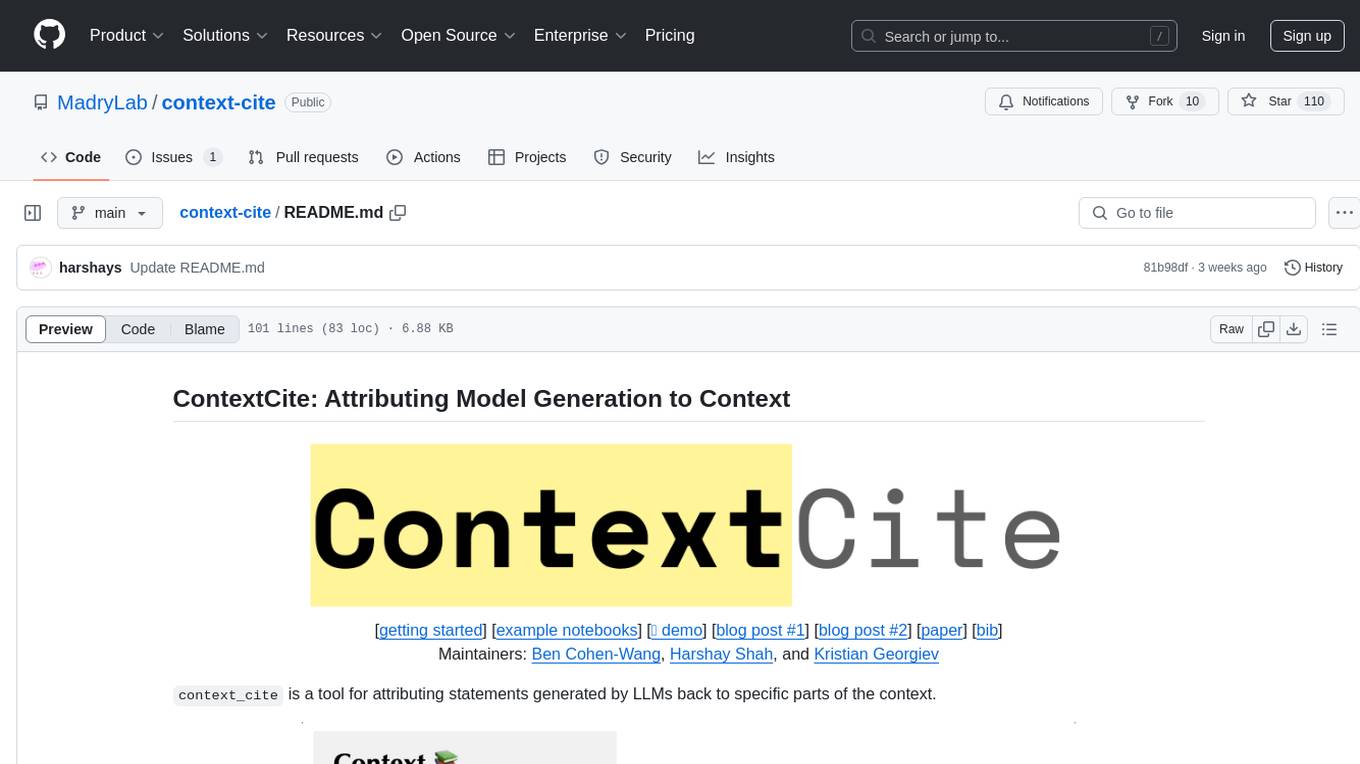
context-cite
ContextCite is a tool for attributing statements generated by LLMs back to specific parts of the context. It allows users to analyze and understand the sources of information used by language models in generating responses. By providing attributions, users can gain insights into how the model makes decisions and where the information comes from.
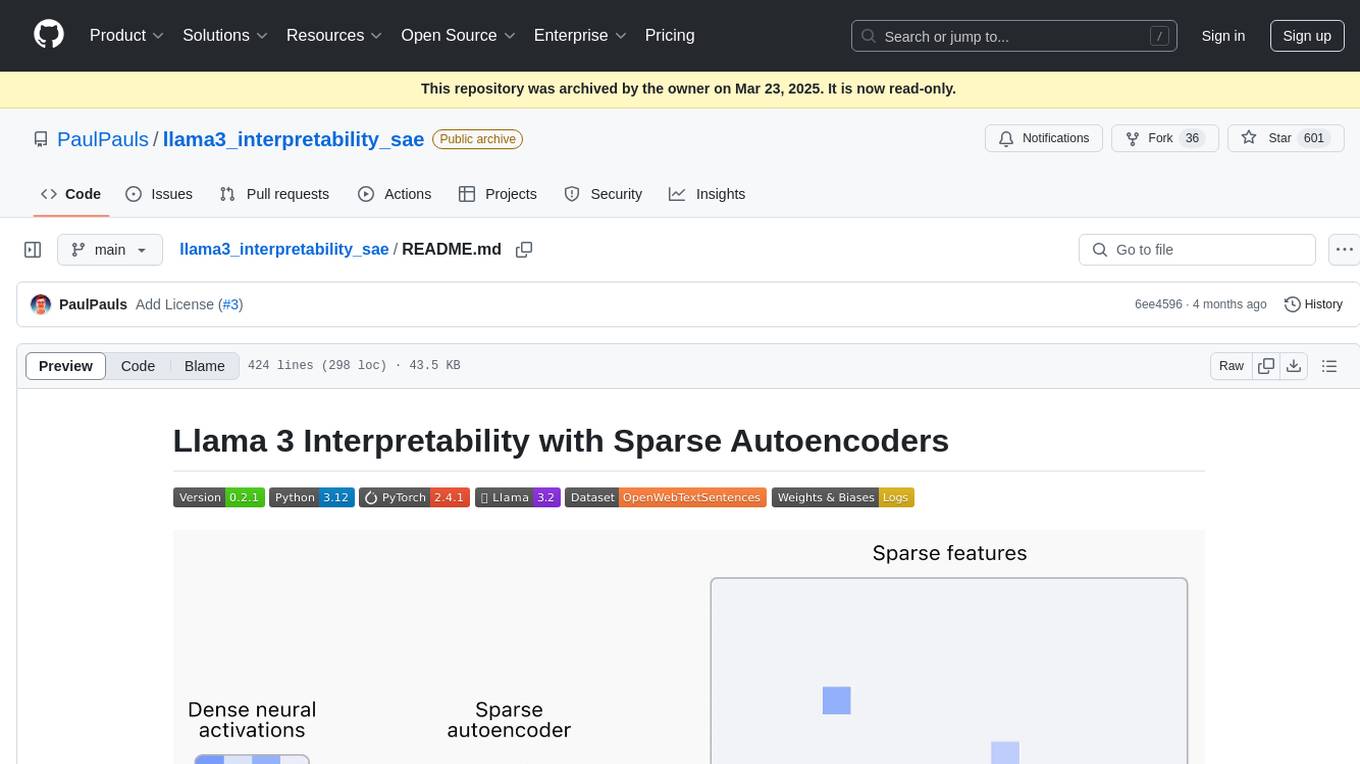
llama3_interpretability_sae
This project focuses on implementing Sparse Autoencoders (SAEs) for mechanistic interpretability in Large Language Models (LLMs) like Llama 3.2-3B. The SAEs aim to untangle superimposed representations in LLMs into separate, interpretable features for each neuron activation. The project provides an end-to-end pipeline for capturing training data, training the SAEs, analyzing learned features, and verifying results experimentally. It includes comprehensive logging, visualization, and checkpointing of SAE training, interpretability analysis tools, and a pure PyTorch implementation of Llama 3.1/3.2 chat and text completion. The project is designed for scalability, efficiency, and maintainability.
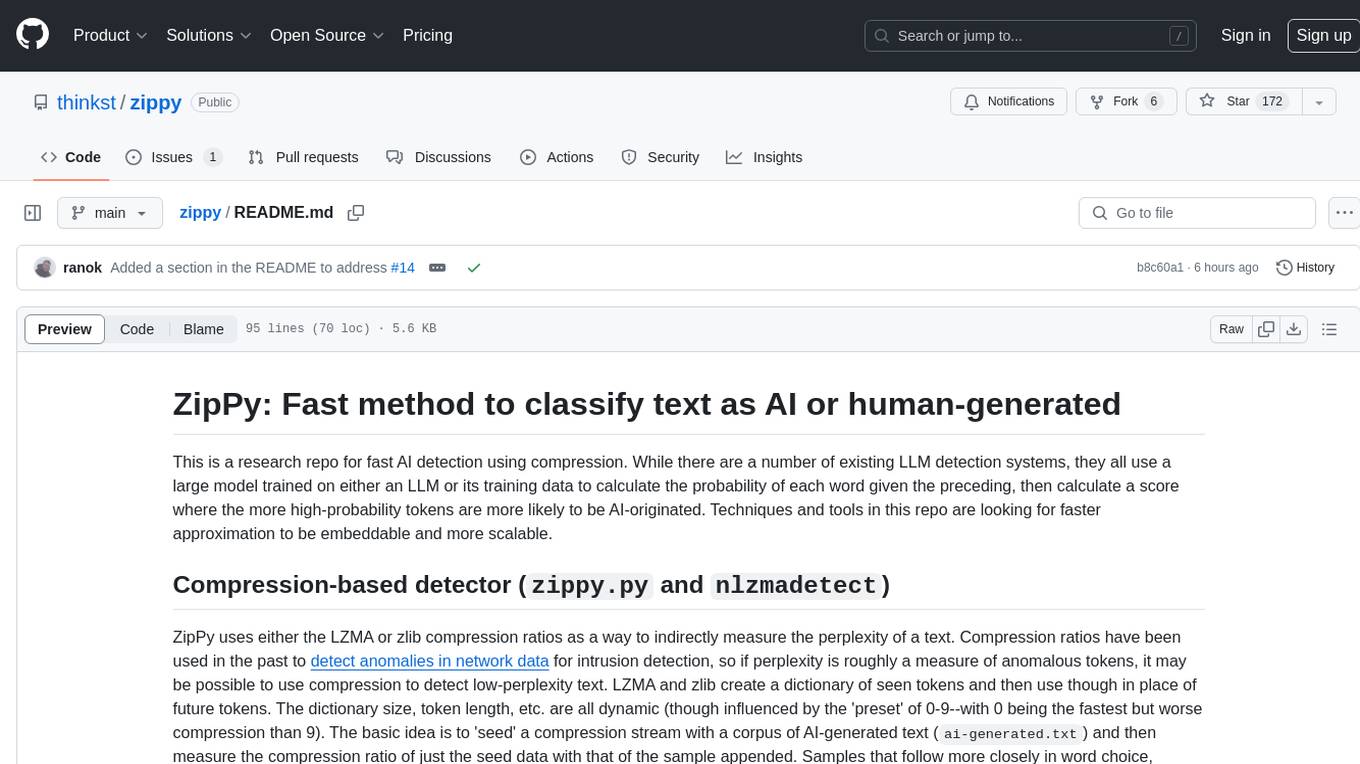
zippy
ZipPy is a research repository focused on fast AI detection using compression techniques. It aims to provide a faster approximation for AI detection that is embeddable and scalable. The tool uses LZMA and zlib compression ratios to indirectly measure the perplexity of a text, allowing for the detection of low-perplexity text. By seeding a compression stream with AI-generated text and comparing the compression ratio of the seed data with the sample appended, ZipPy can identify similarities in word choice and structure to classify text as AI or human-generated.
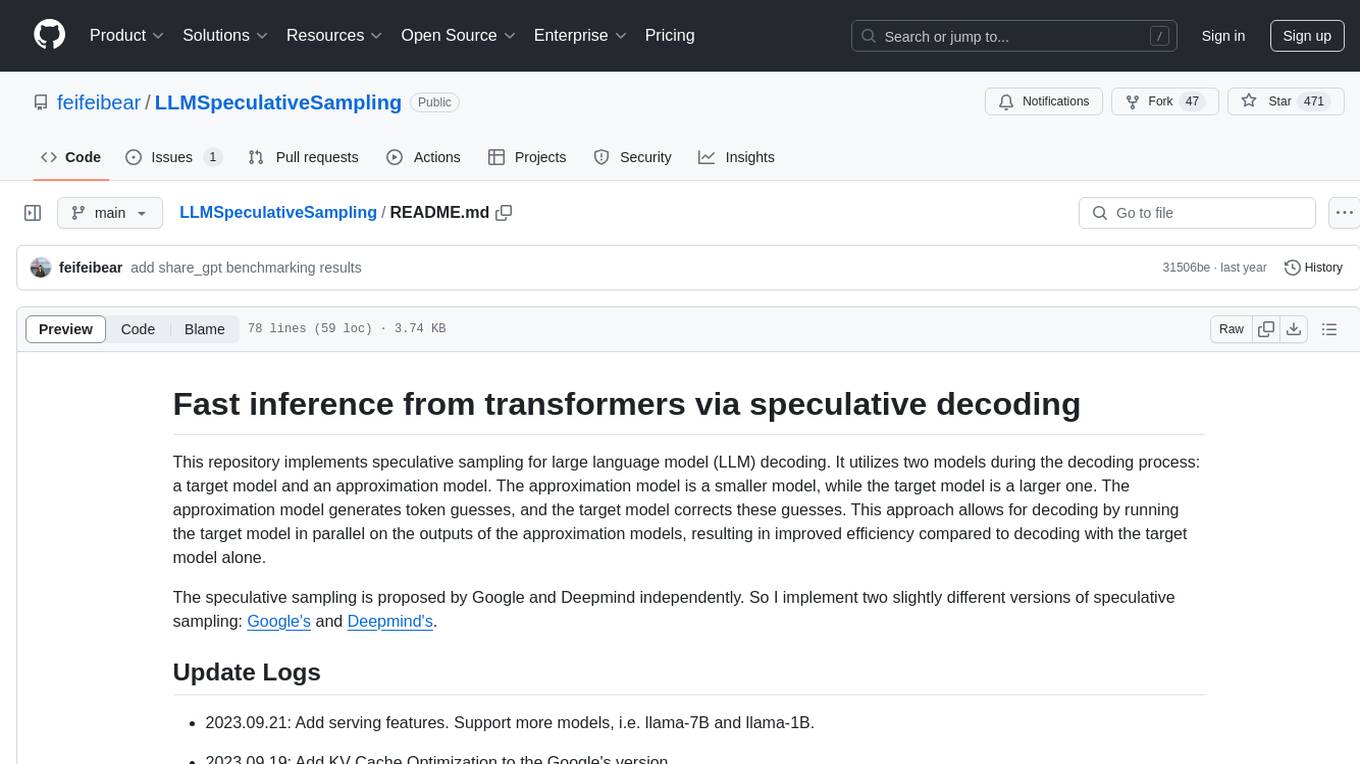
LLMSpeculativeSampling
This repository implements speculative sampling for large language model (LLM) decoding, utilizing two models - a target model and an approximation model. The approximation model generates token guesses, corrected by the target model, resulting in improved efficiency. It includes implementations of Google's and Deepmind's versions of speculative sampling, supporting models like llama-7B and llama-1B. The tool is designed for fast inference from transformers via speculative decoding.
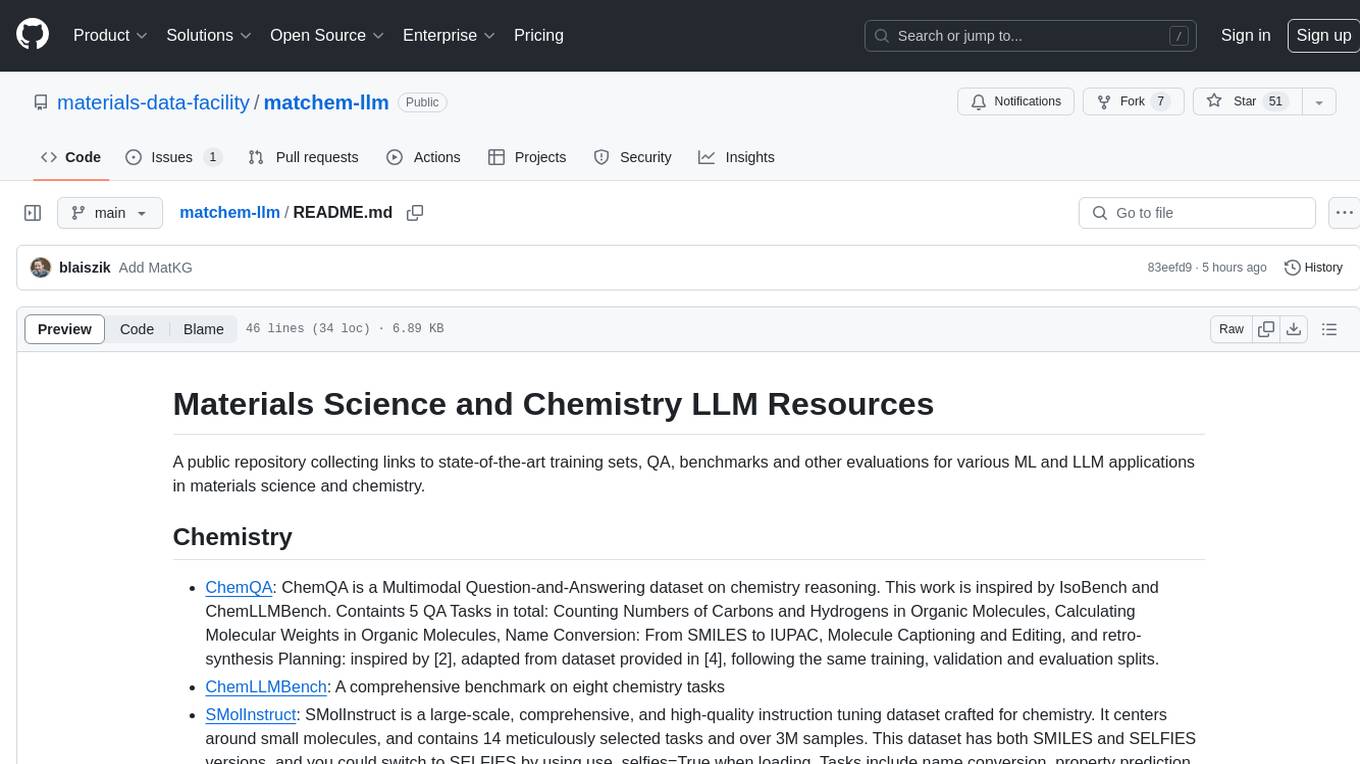
matchem-llm
A public repository collecting links to state-of-the-art training sets, QA, benchmarks and other evaluations for various ML and LLM applications in materials science and chemistry. It includes datasets related to chemistry, materials, multimodal data, and knowledge graphs in the field. The repository aims to provide resources for training and evaluating machine learning models in the materials science and chemistry domains.
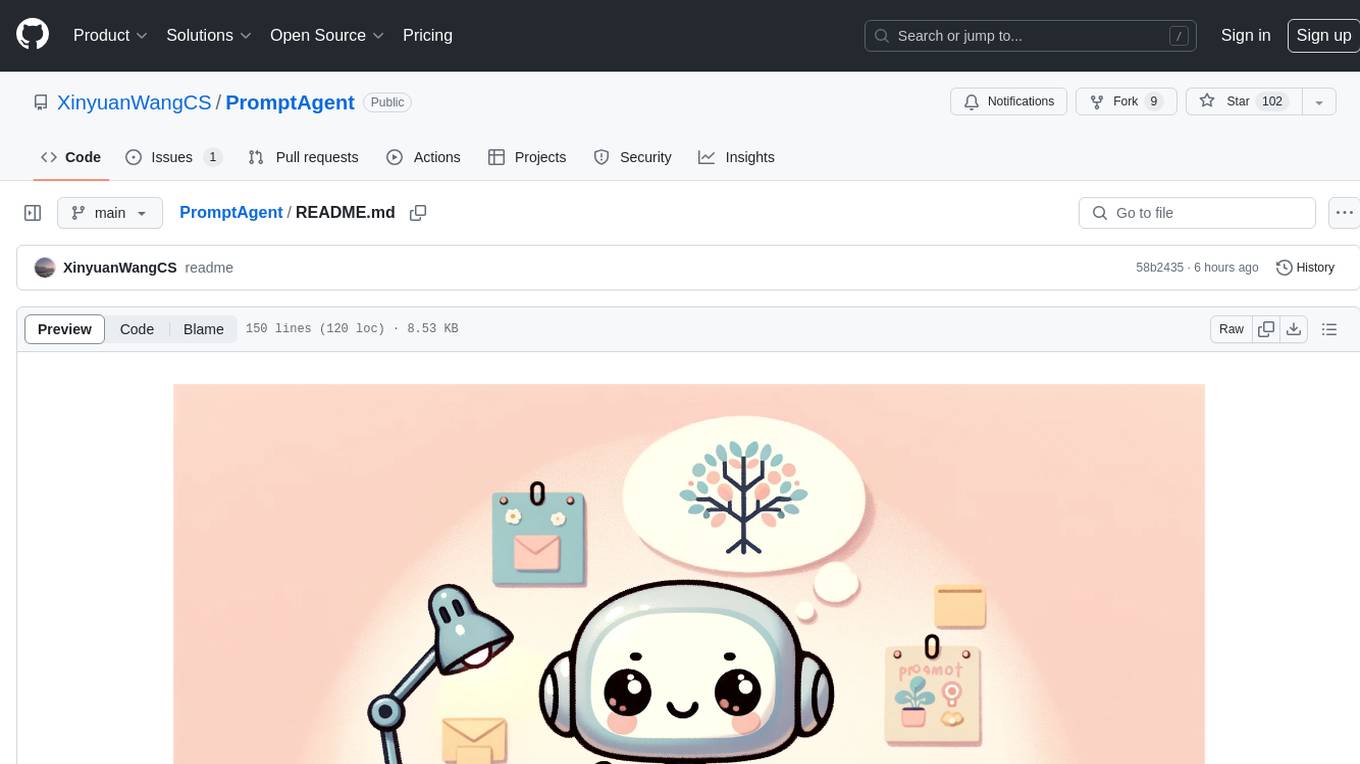
PromptAgent
PromptAgent is a repository for a novel automatic prompt optimization method that crafts expert-level prompts using language models. It provides a principled framework for prompt optimization by unifying prompt sampling and rewarding using MCTS algorithm. The tool supports different models like openai, palm, and huggingface models. Users can run PromptAgent to optimize prompts for specific tasks by strategically sampling model errors, generating error feedbacks, simulating future rewards, and searching for high-reward paths leading to expert prompts.
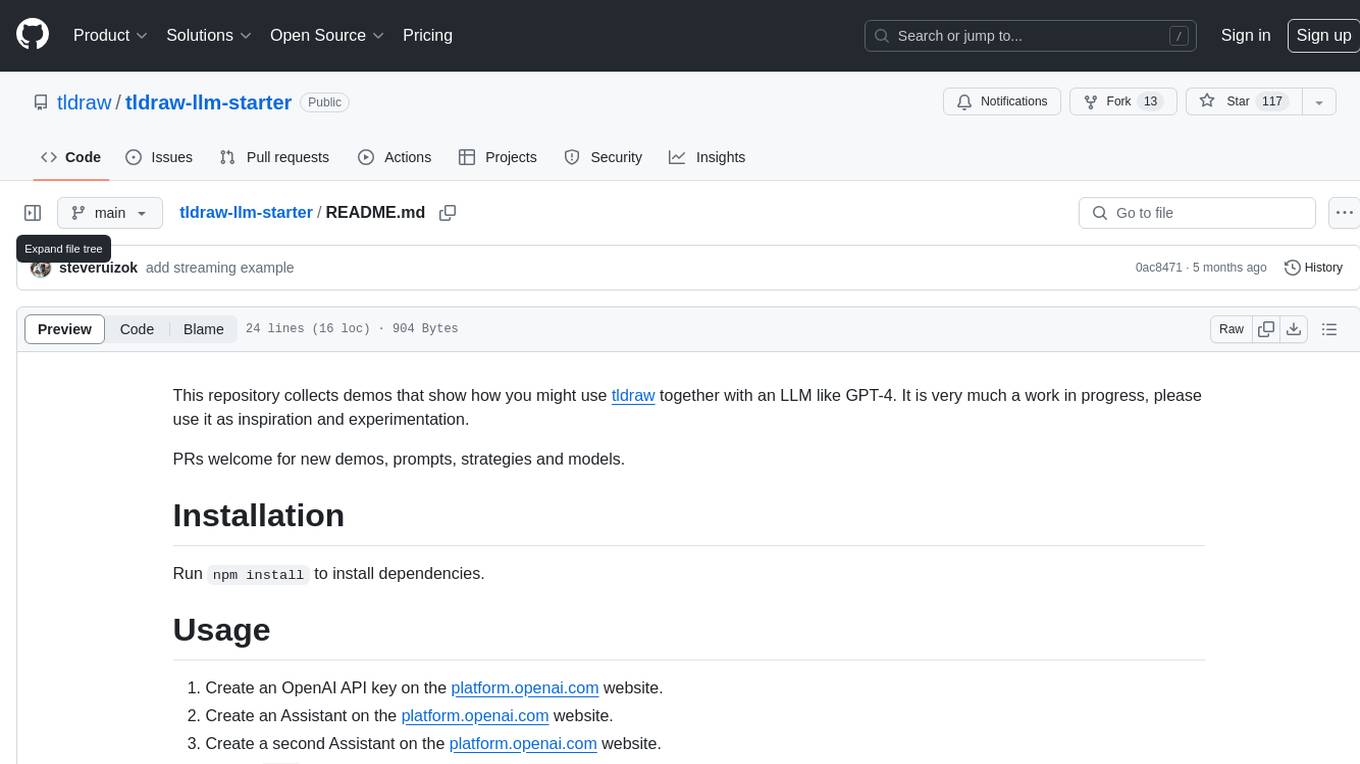
tldraw-llm-starter
This repository is a collection of demos showcasing how to integrate tldraw with an LLM like GPT-4. It serves as a work in progress for inspiration and experimentation. Users can contribute new demos, prompts, strategies, and models. The installation process involves running 'npm install' to install dependencies. Usage instructions include creating OpenAI API keys and assistants on the platform.openai.com website, as well as setting up a '.env' file with necessary credentials. The server can be started with 'npm run dev'. The repository aims to demonstrate the potential synergy between tldraw and GPT-4 for various applications.
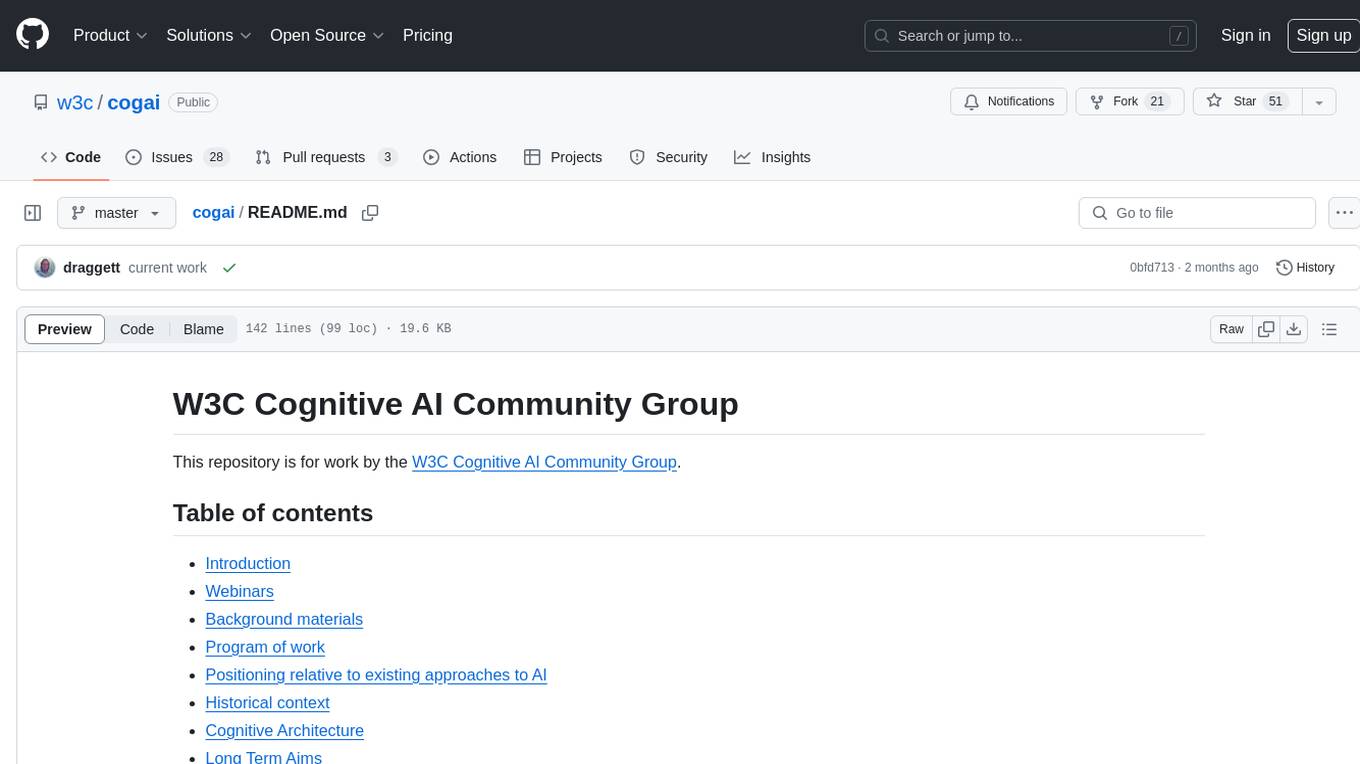
cogai
The W3C Cognitive AI Community Group focuses on advancing Cognitive AI through collaboration on defining use cases, open source implementations, and application areas. The group aims to demonstrate the potential of Cognitive AI in various domains such as customer services, healthcare, cybersecurity, online learning, autonomous vehicles, manufacturing, and web search. They work on formal specifications for chunk data and rules, plausible knowledge notation, and neural networks for human-like AI. The group positions Cognitive AI as a combination of symbolic and statistical approaches inspired by human thought processes. They address research challenges including mimicry, emotional intelligence, natural language processing, and common sense reasoning. The long-term goal is to develop cognitive agents that are knowledgeable, creative, collaborative, empathic, and multilingual, capable of continual learning and self-awareness.
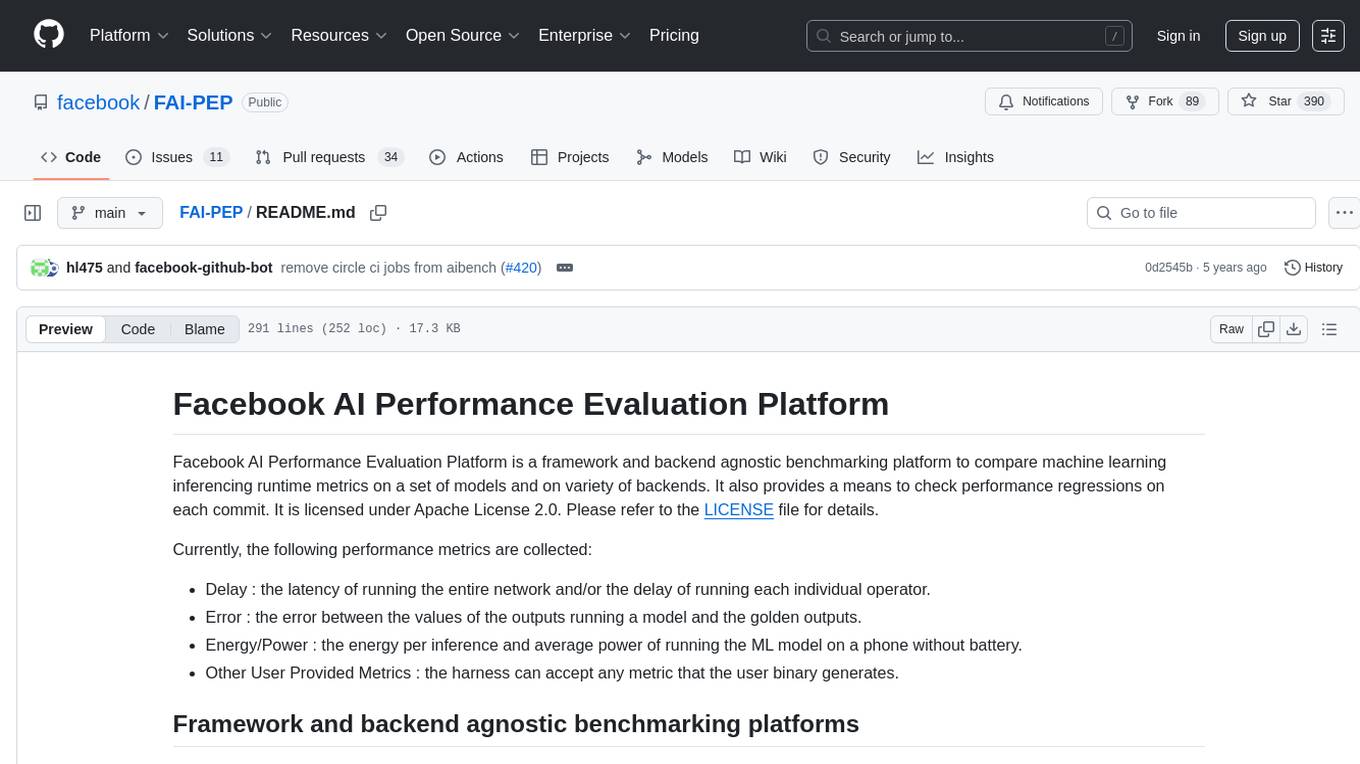
FAI-PEP
Facebook AI Performance Evaluation Platform is a framework and backend agnostic benchmarking platform to compare machine learning inferencing runtime metrics on a set of models and on a variety of backends. It provides a means to check performance regressions on each commit. The platform supports various performance metrics such as delay, error, energy/power, and user-provided metrics. It aims to easily evaluate the runtime performance of models and backends across different frameworks and platforms. The platform uses a centralized model/benchmark specification, fair input comparison, distributed benchmark execution, and centralized data consumption to reduce variation and provide a one-stop solution for performance comparison. Supported frameworks include Caffe2 and TFLite, while backends include CPU, GPU, DSP, Android, iOS, and Linux based systems. The platform also offers performance regression detection using A/B testing methodology to compare runtime differences between commits.

Me-LLaMA
Me LLaMA introduces a suite of open-source medical Large Language Models (LLMs), including Me LLaMA 13B/70B and their chat-enhanced versions. Developed through innovative continual pre-training and instruction tuning, these models leverage a vast medical corpus comprising PubMed papers, medical guidelines, and general domain data. Me LLaMA sets new benchmarks on medical reasoning tasks, making it a significant asset for medical NLP applications and research. The models are intended for computational linguistics and medical research, not for clinical decision-making without validation and regulatory approval.
For similar tasks
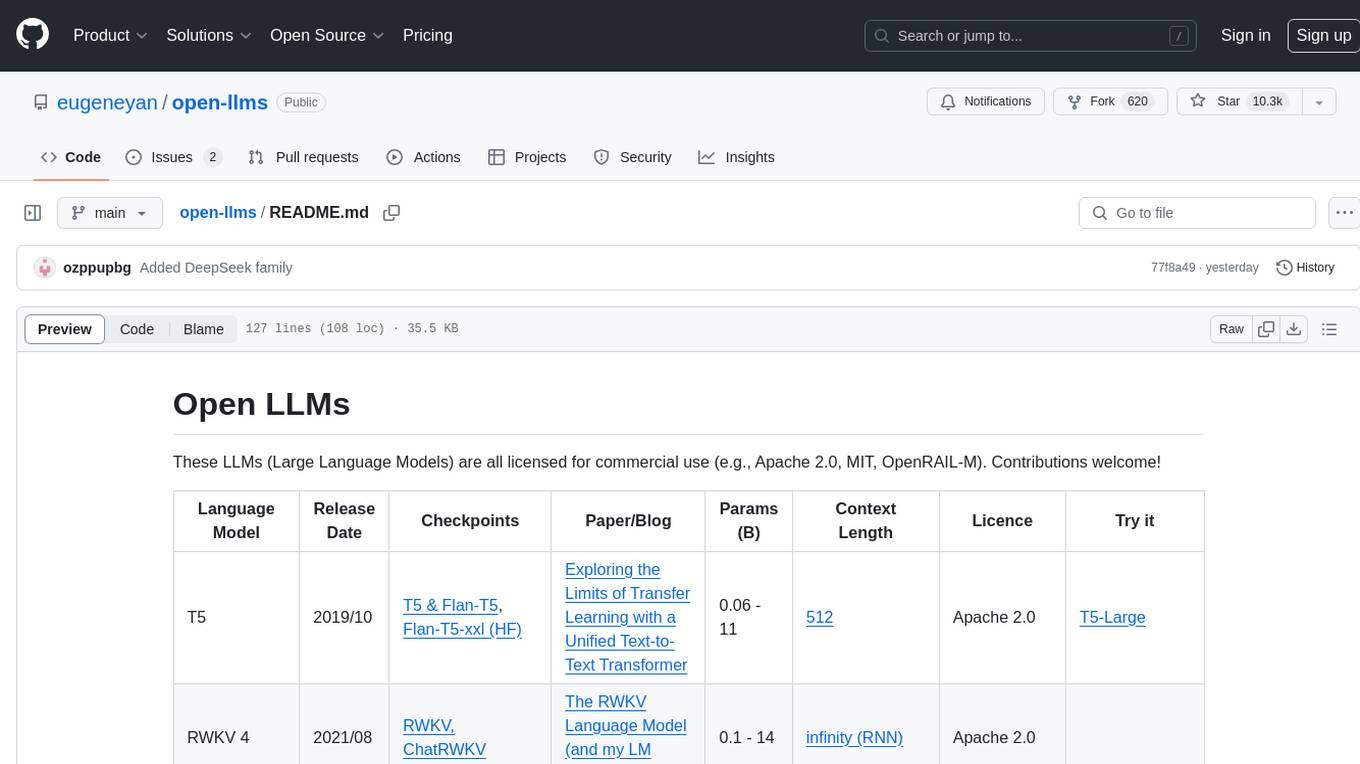
open-llms
Open LLMs is a repository containing various Large Language Models licensed for commercial use. It includes models like T5, GPT-NeoX, UL2, Bloom, Cerebras-GPT, Pythia, Dolly, and more. These models are designed for tasks such as transfer learning, language understanding, chatbot development, code generation, and more. The repository provides information on release dates, checkpoints, papers/blogs, parameters, context length, and licenses for each model. Contributions to the repository are welcome, and it serves as a resource for exploring the capabilities of different language models.
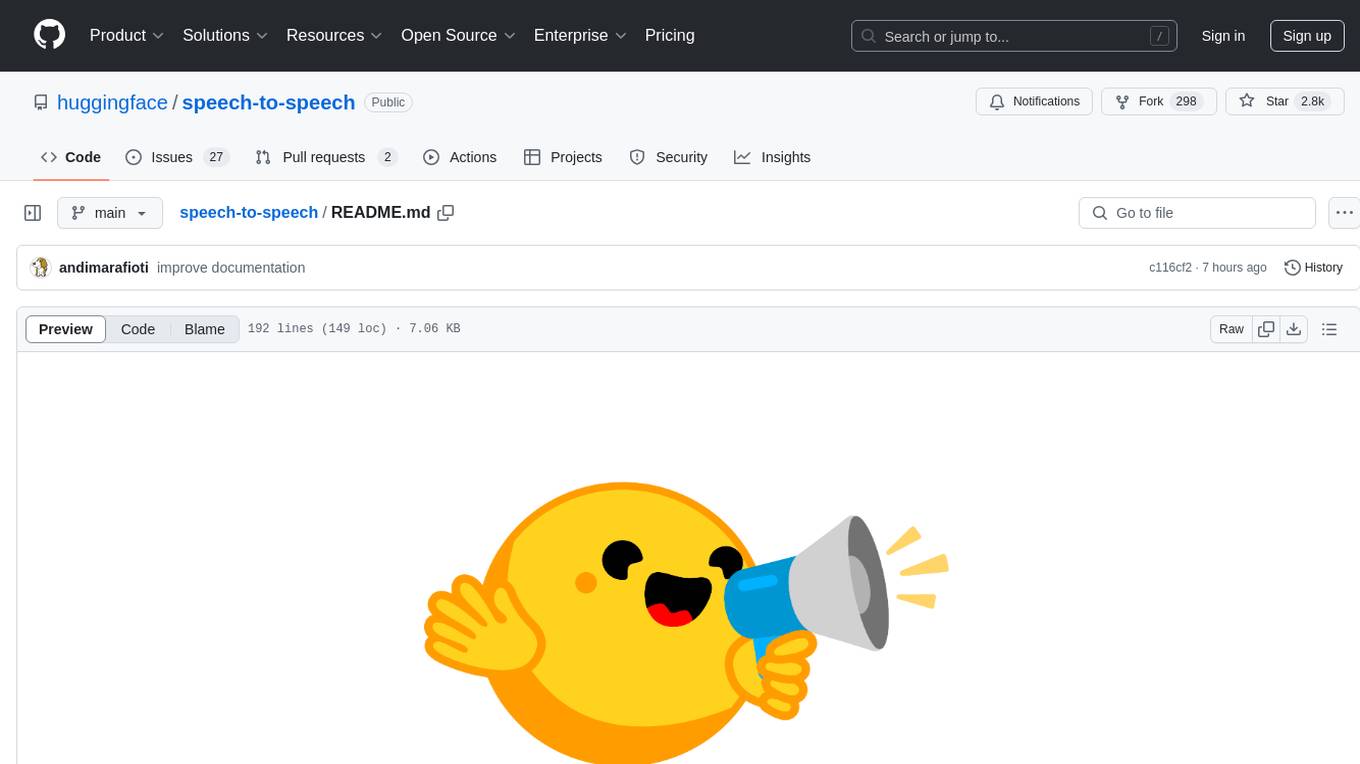
speech-to-speech
This repository implements a speech-to-speech cascaded pipeline with consecutive parts including Voice Activity Detection (VAD), Speech to Text (STT), Language Model (LM), and Text to Speech (TTS). It aims to provide a fully open and modular approach by leveraging models available on the Transformers library via the Hugging Face hub. The code is designed for easy modification, with each component implemented as a class. Users can run the pipeline either on a server/client approach or locally, with detailed setup and usage instructions provided in the readme.
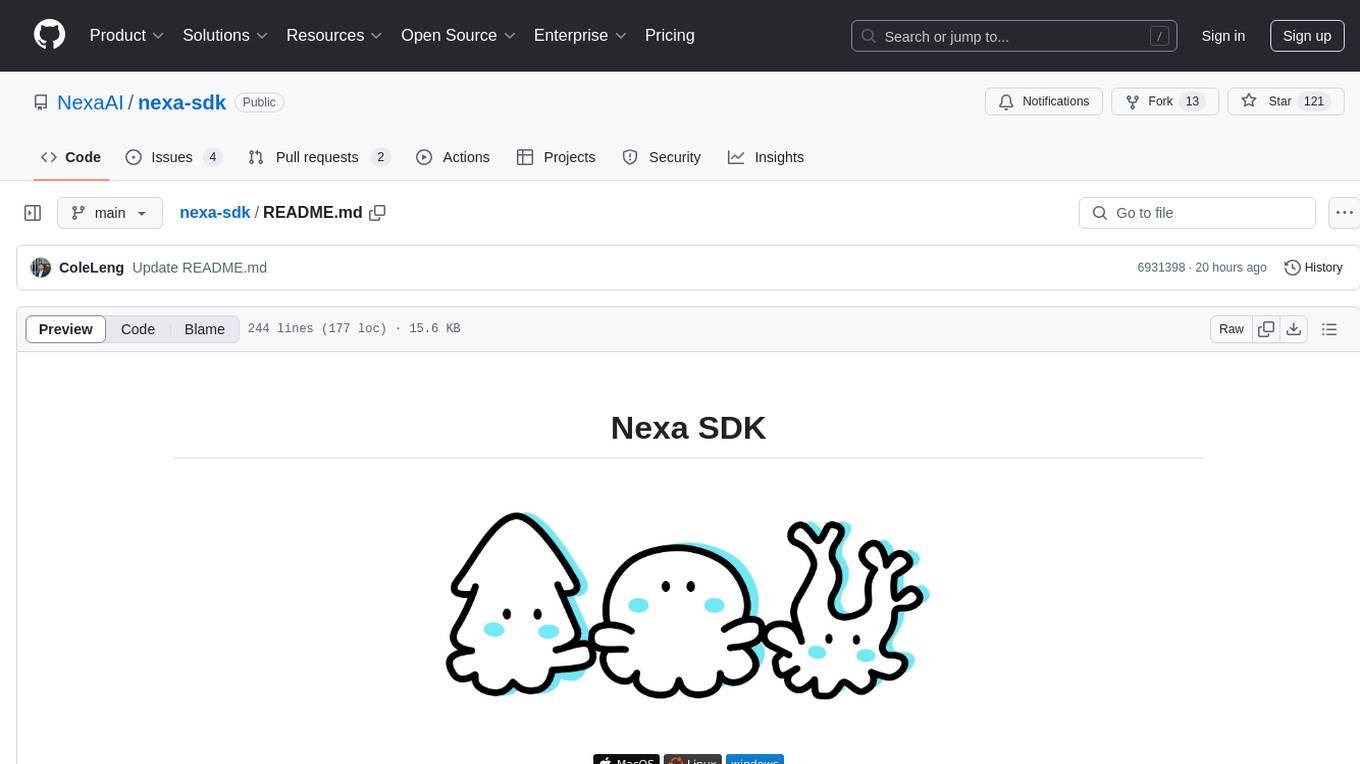
nexa-sdk
Nexa SDK is a comprehensive toolkit supporting ONNX and GGML models for text generation, image generation, vision-language models (VLM), and text-to-speech (TTS) capabilities. It offers an OpenAI-compatible API server with JSON schema mode and streaming support, along with a user-friendly Streamlit UI. Users can run Nexa SDK on any device with Python environment, with GPU acceleration supported. The toolkit provides model support, conversion engine, inference engine for various tasks, and differentiating features from other tools.

text2text
Text2Text is a comprehensive language modeling toolkit that offers a wide range of functionalities for text processing and generation. It provides tools for tokenization, embedding, TF-IDF calculations, BM25 scoring, indexing, translation, data augmentation, distance measurement, training/finetuning models, language identification, and serving models via a web server. The toolkit is designed to be user-friendly and efficient, offering a variety of features for natural language processing tasks.

LLMStack
LLMStack is a no-code platform for building generative AI agents, workflows, and chatbots. It allows users to connect their own data, internal tools, and GPT-powered models without any coding experience. LLMStack can be deployed to the cloud or on-premise and can be accessed via HTTP API or triggered from Slack or Discord.
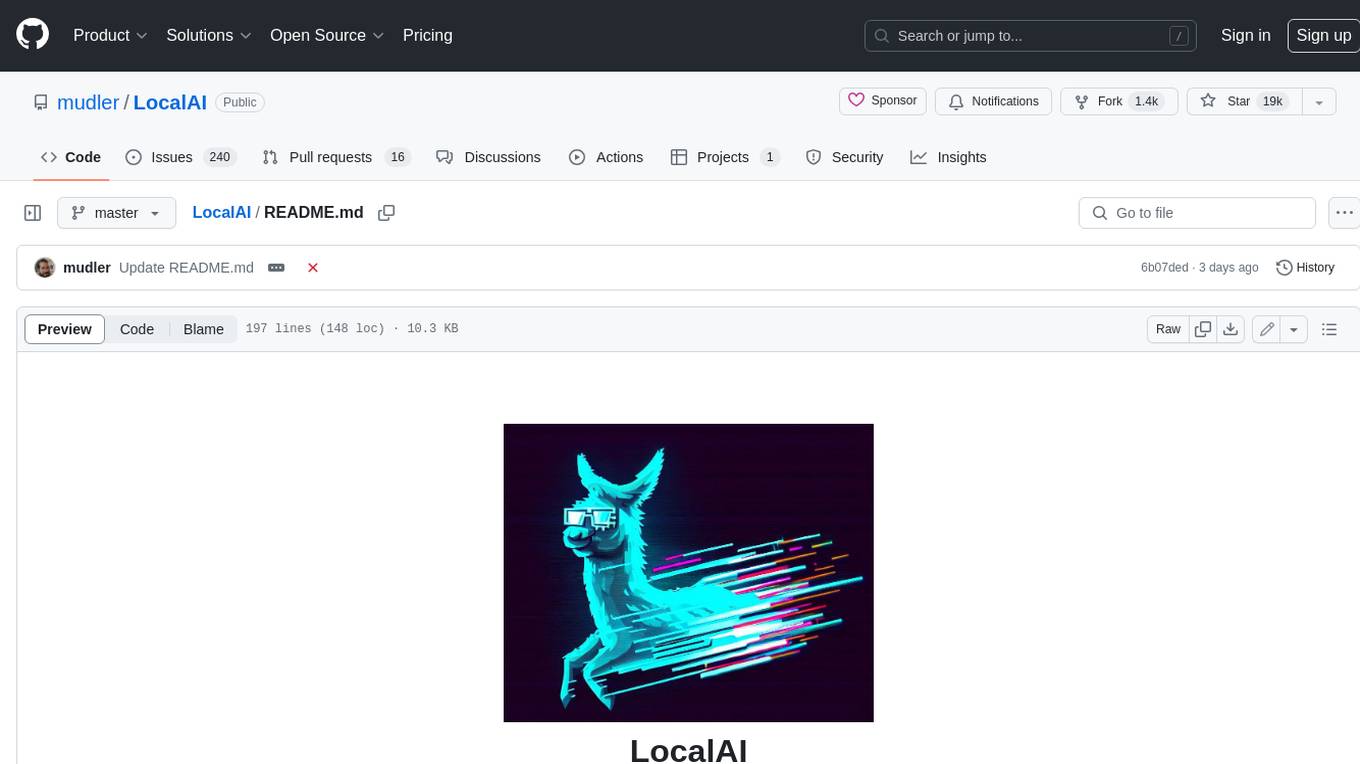
LocalAI
LocalAI is a free and open-source OpenAI alternative that acts as a drop-in replacement REST API compatible with OpenAI (Elevenlabs, Anthropic, etc.) API specifications for local AI inferencing. It allows users to run LLMs, generate images, audio, and more locally or on-premises with consumer-grade hardware, supporting multiple model families and not requiring a GPU. LocalAI offers features such as text generation with GPTs, text-to-audio, audio-to-text transcription, image generation with stable diffusion, OpenAI functions, embeddings generation for vector databases, constrained grammars, downloading models directly from Huggingface, and a Vision API. It provides a detailed step-by-step introduction in its Getting Started guide and supports community integrations such as custom containers, WebUIs, model galleries, and various bots for Discord, Slack, and Telegram. LocalAI also offers resources like an LLM fine-tuning guide, instructions for local building and Kubernetes installation, projects integrating LocalAI, and a how-tos section curated by the community. It encourages users to cite the repository when utilizing it in downstream projects and acknowledges the contributions of various software from the community.
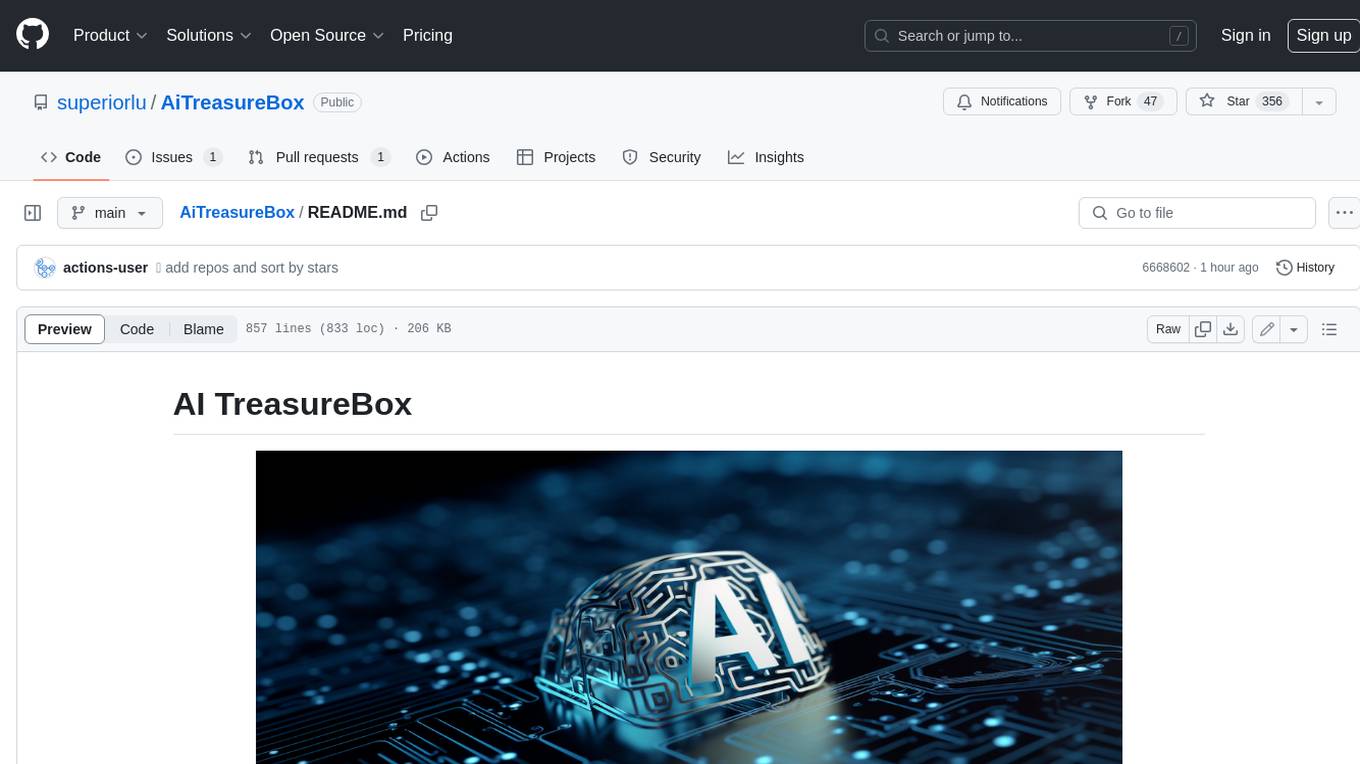
AiTreasureBox
AiTreasureBox is a versatile AI tool that provides a collection of pre-trained models and algorithms for various machine learning tasks. It simplifies the process of implementing AI solutions by offering ready-to-use components that can be easily integrated into projects. With AiTreasureBox, users can quickly prototype and deploy AI applications without the need for extensive knowledge in machine learning or deep learning. The tool covers a wide range of tasks such as image classification, text generation, sentiment analysis, object detection, and more. It is designed to be user-friendly and accessible to both beginners and experienced developers, making AI development more efficient and accessible to a wider audience.
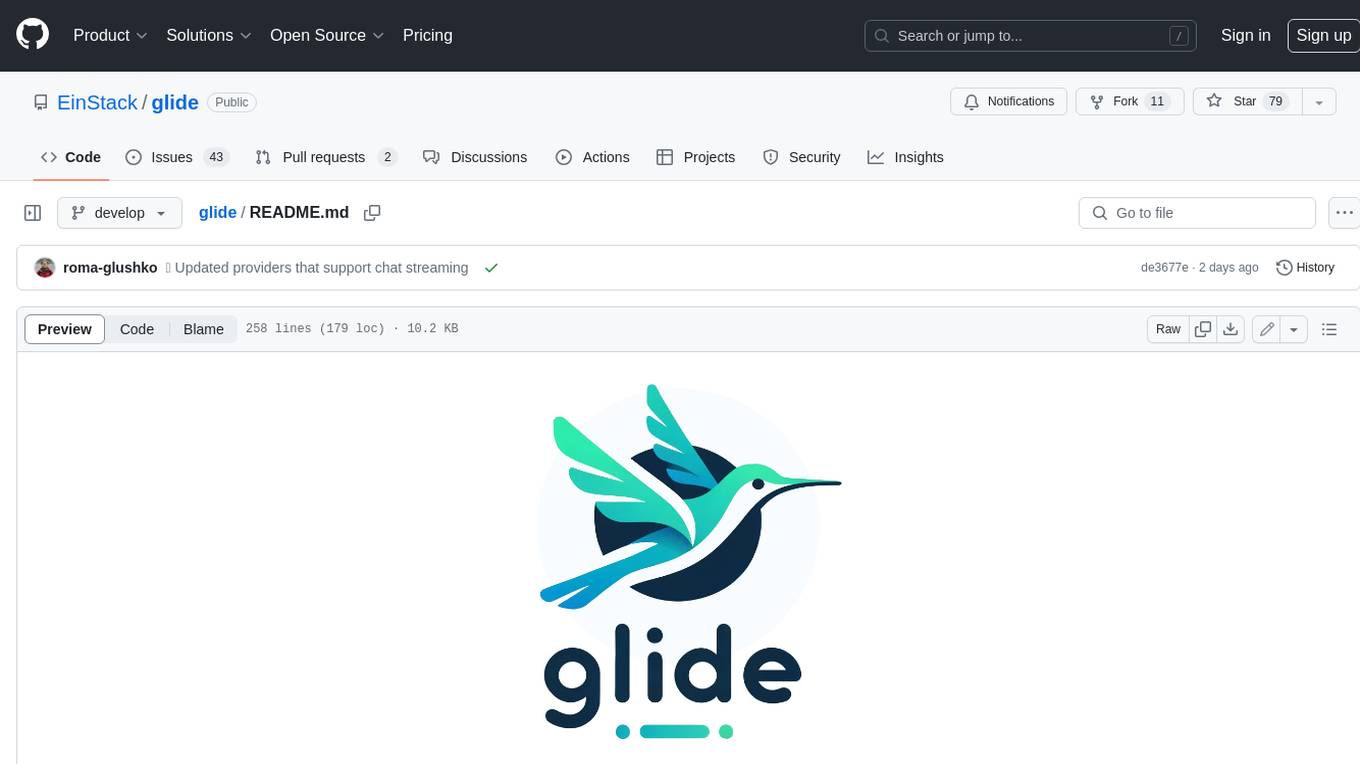
glide
Glide is a cloud-native LLM gateway that provides a unified REST API for accessing various large language models (LLMs) from different providers. It handles LLMOps tasks such as model failover, caching, key management, and more, making it easy to integrate LLMs into applications. Glide supports popular LLM providers like OpenAI, Anthropic, Azure OpenAI, AWS Bedrock (Titan), Cohere, Google Gemini, OctoML, and Ollama. It offers high availability, performance, and observability, and provides SDKs for Python and NodeJS to simplify integration.
For similar jobs

promptflow
**Prompt flow** is a suite of development tools designed to streamline the end-to-end development cycle of LLM-based AI applications, from ideation, prototyping, testing, evaluation to production deployment and monitoring. It makes prompt engineering much easier and enables you to build LLM apps with production quality.

deepeval
DeepEval is a simple-to-use, open-source LLM evaluation framework specialized for unit testing LLM outputs. It incorporates various metrics such as G-Eval, hallucination, answer relevancy, RAGAS, etc., and runs locally on your machine for evaluation. It provides a wide range of ready-to-use evaluation metrics, allows for creating custom metrics, integrates with any CI/CD environment, and enables benchmarking LLMs on popular benchmarks. DeepEval is designed for evaluating RAG and fine-tuning applications, helping users optimize hyperparameters, prevent prompt drifting, and transition from OpenAI to hosting their own Llama2 with confidence.
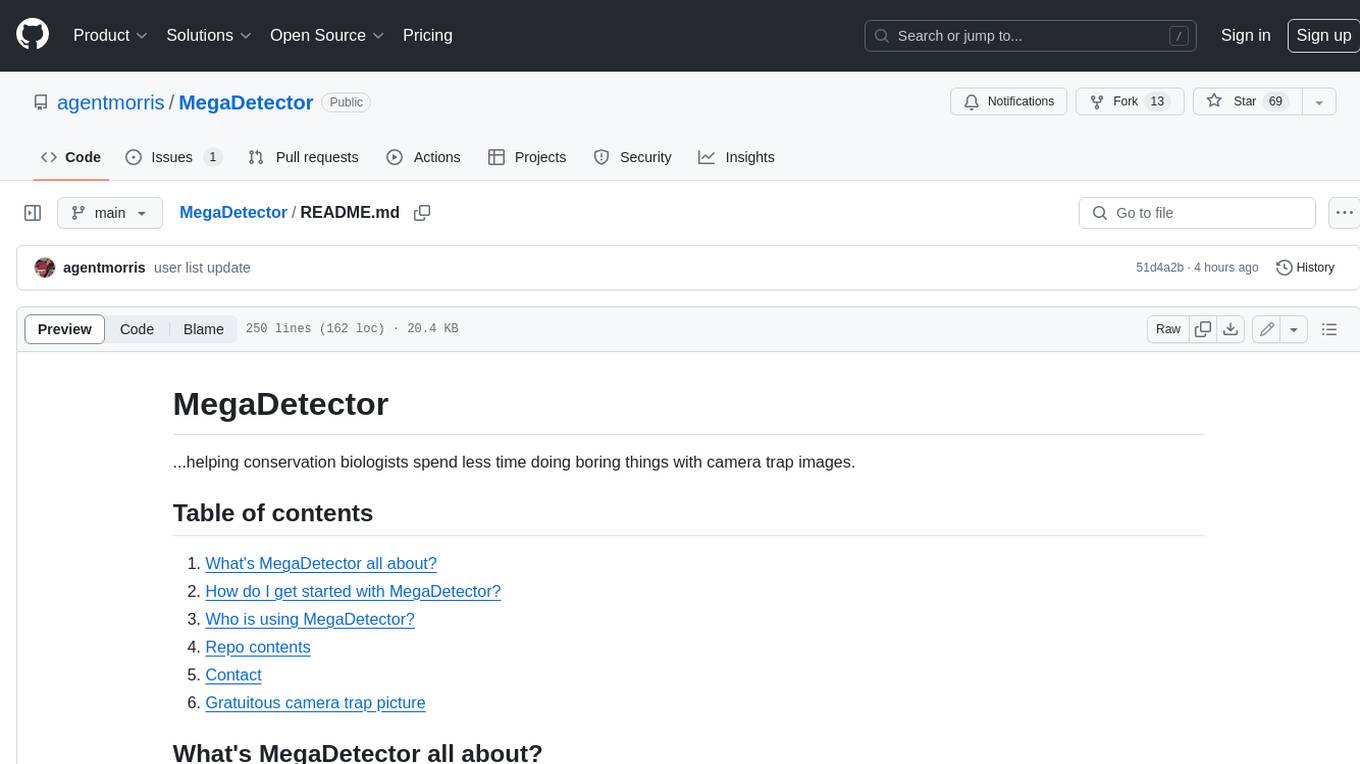
MegaDetector
MegaDetector is an AI model that identifies animals, people, and vehicles in camera trap images (which also makes it useful for eliminating blank images). This model is trained on several million images from a variety of ecosystems. MegaDetector is just one of many tools that aims to make conservation biologists more efficient with AI. If you want to learn about other ways to use AI to accelerate camera trap workflows, check out our of the field, affectionately titled "Everything I know about machine learning and camera traps".

leapfrogai
LeapfrogAI is a self-hosted AI platform designed to be deployed in air-gapped resource-constrained environments. It brings sophisticated AI solutions to these environments by hosting all the necessary components of an AI stack, including vector databases, model backends, API, and UI. LeapfrogAI's API closely matches that of OpenAI, allowing tools built for OpenAI/ChatGPT to function seamlessly with a LeapfrogAI backend. It provides several backends for various use cases, including llama-cpp-python, whisper, text-embeddings, and vllm. LeapfrogAI leverages Chainguard's apko to harden base python images, ensuring the latest supported Python versions are used by the other components of the stack. The LeapfrogAI SDK provides a standard set of protobuffs and python utilities for implementing backends and gRPC. LeapfrogAI offers UI options for common use-cases like chat, summarization, and transcription. It can be deployed and run locally via UDS and Kubernetes, built out using Zarf packages. LeapfrogAI is supported by a community of users and contributors, including Defense Unicorns, Beast Code, Chainguard, Exovera, Hypergiant, Pulze, SOSi, United States Navy, United States Air Force, and United States Space Force.

llava-docker
This Docker image for LLaVA (Large Language and Vision Assistant) provides a convenient way to run LLaVA locally or on RunPod. LLaVA is a powerful AI tool that combines natural language processing and computer vision capabilities. With this Docker image, you can easily access LLaVA's functionalities for various tasks, including image captioning, visual question answering, text summarization, and more. The image comes pre-installed with LLaVA v1.2.0, Torch 2.1.2, xformers 0.0.23.post1, and other necessary dependencies. You can customize the model used by setting the MODEL environment variable. The image also includes a Jupyter Lab environment for interactive development and exploration. Overall, this Docker image offers a comprehensive and user-friendly platform for leveraging LLaVA's capabilities.

carrot
The 'carrot' repository on GitHub provides a list of free and user-friendly ChatGPT mirror sites for easy access. The repository includes sponsored sites offering various GPT models and services. Users can find and share sites, report errors, and access stable and recommended sites for ChatGPT usage. The repository also includes a detailed list of ChatGPT sites, their features, and accessibility options, making it a valuable resource for ChatGPT users seeking free and unlimited GPT services.

TrustLLM
TrustLLM is a comprehensive study of trustworthiness in LLMs, including principles for different dimensions of trustworthiness, established benchmark, evaluation, and analysis of trustworthiness for mainstream LLMs, and discussion of open challenges and future directions. Specifically, we first propose a set of principles for trustworthy LLMs that span eight different dimensions. Based on these principles, we further establish a benchmark across six dimensions including truthfulness, safety, fairness, robustness, privacy, and machine ethics. We then present a study evaluating 16 mainstream LLMs in TrustLLM, consisting of over 30 datasets. The document explains how to use the trustllm python package to help you assess the performance of your LLM in trustworthiness more quickly. For more details about TrustLLM, please refer to project website.
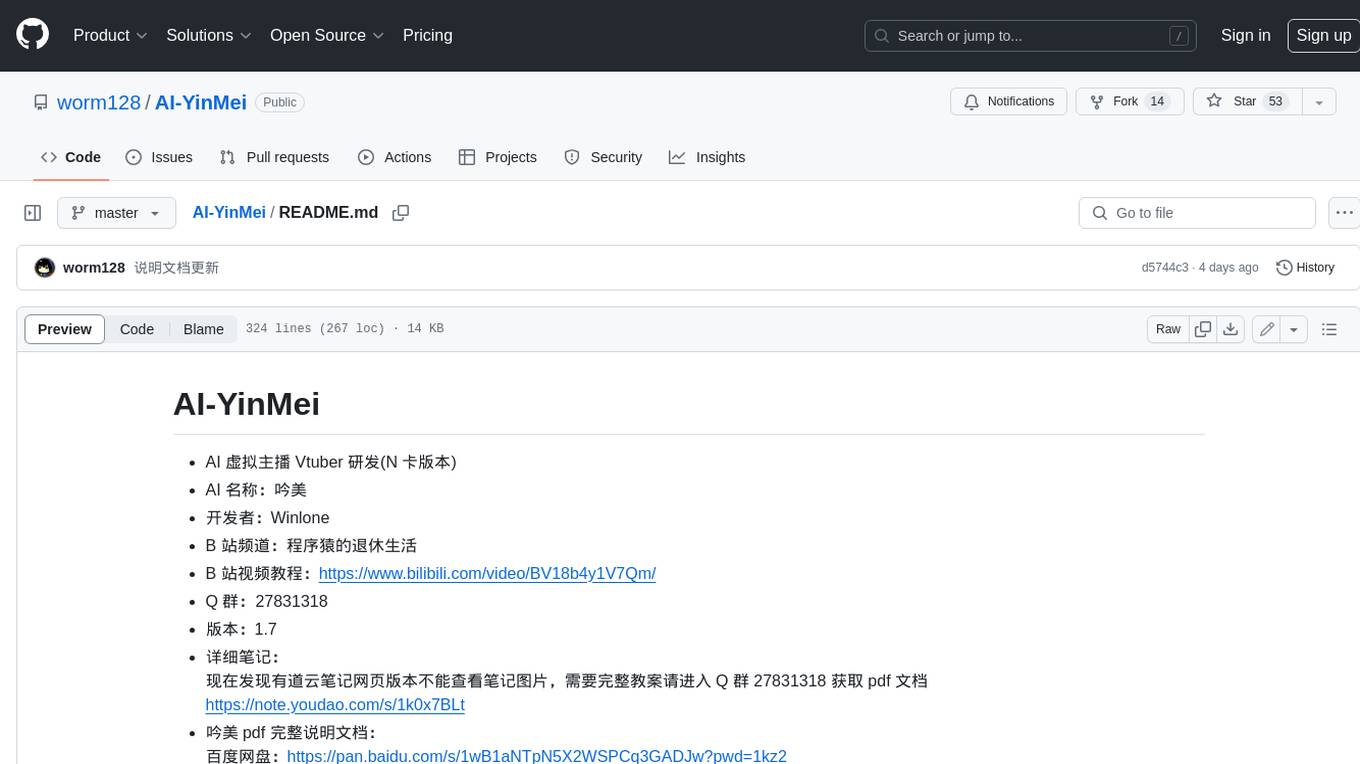
AI-YinMei
AI-YinMei is an AI virtual anchor Vtuber development tool (N card version). It supports fastgpt knowledge base chat dialogue, a complete set of solutions for LLM large language models: [fastgpt] + [one-api] + [Xinference], supports docking bilibili live broadcast barrage reply and entering live broadcast welcome speech, supports Microsoft edge-tts speech synthesis, supports Bert-VITS2 speech synthesis, supports GPT-SoVITS speech synthesis, supports expression control Vtuber Studio, supports painting stable-diffusion-webui output OBS live broadcast room, supports painting picture pornography public-NSFW-y-distinguish, supports search and image search service duckduckgo (requires magic Internet access), supports image search service Baidu image search (no magic Internet access), supports AI reply chat box [html plug-in], supports AI singing Auto-Convert-Music, supports playlist [html plug-in], supports dancing function, supports expression video playback, supports head touching action, supports gift smashing action, supports singing automatic start dancing function, chat and singing automatic cycle swing action, supports multi scene switching, background music switching, day and night automatic switching scene, supports open singing and painting, let AI automatically judge the content.